Financial and Business Performance Running Head: Financial and Business Performance Information
VerifiedAdded on 2022/10/14
|28
|5156
|143
AI Summary
With the given information, we would calculate the ratios of 2017 and 2018 and also analyse the results to know whether the impact of the investment on the ratios would be positive or negative. Financial Statements of Lynch Quality Goods INCOME STATEMENTS Income Statement (2016/17) $ 80,000 $ Revenue 7,20,000 Less COGS Opening Stock 25,000 Purchases 3,10,000 Less Closing Stock 28,000 3,07,000 Gross Profit Loan 4,80,000 RATIO Depreciation 2,200,000 Total Assets Payable RATIO Depreciation 3
Contribute Materials
Your contribution can guide someone’s learning journey. Share your
documents today.
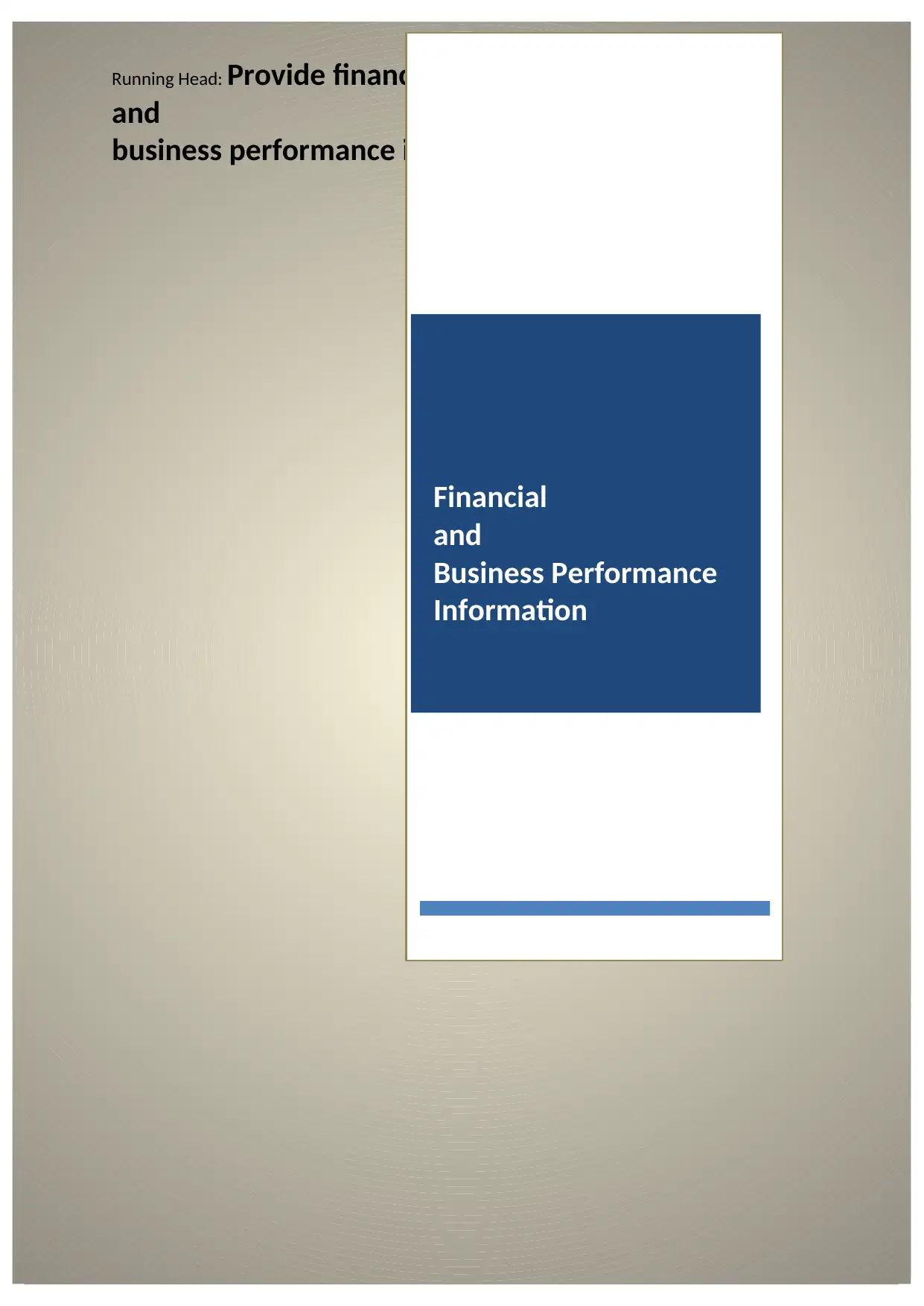
Running Head: Provide financial
and
business performance information
Financial
and
Business Performance
Information
and
business performance information
Financial
and
Business Performance
Information
Secure Best Marks with AI Grader
Need help grading? Try our AI Grader for instant feedback on your assignments.
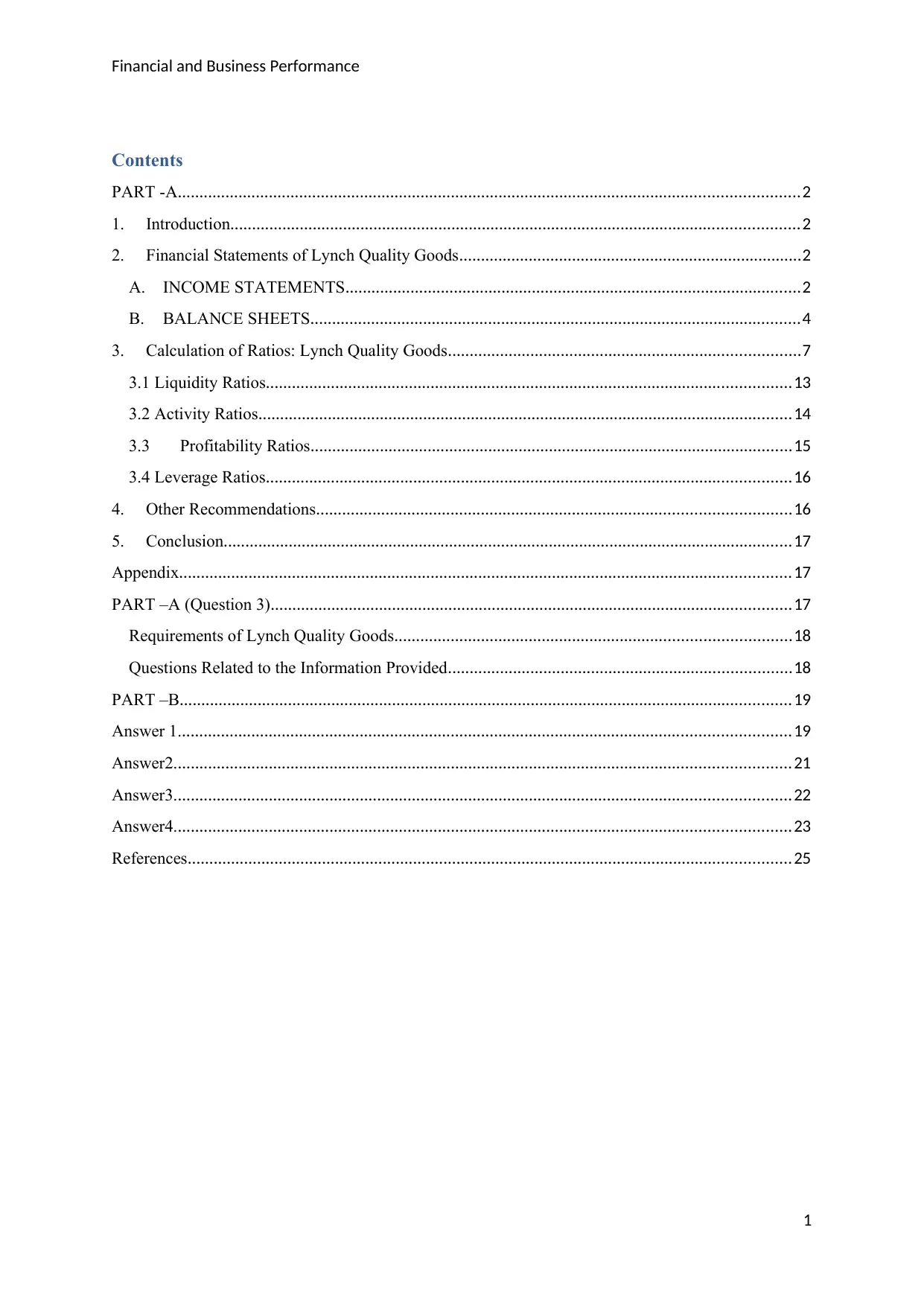
Financial and Business Performance
Contents
PART -A...............................................................................................................................................2
1. Introduction...................................................................................................................................2
2. Financial Statements of Lynch Quality Goods...............................................................................2
A. INCOME STATEMENTS.........................................................................................................2
B. BALANCE SHEETS.................................................................................................................4
3. Calculation of Ratios: Lynch Quality Goods.................................................................................7
3.1 Liquidity Ratios.........................................................................................................................13
3.2 Activity Ratios...........................................................................................................................14
3.3 Profitability Ratios...............................................................................................................15
3.4 Leverage Ratios.........................................................................................................................16
4. Other Recommendations.............................................................................................................16
5. Conclusion...................................................................................................................................17
Appendix.............................................................................................................................................17
PART –A (Question 3)........................................................................................................................17
Requirements of Lynch Quality Goods...........................................................................................18
Questions Related to the Information Provided...............................................................................18
PART –B.............................................................................................................................................19
Answer 1.............................................................................................................................................19
Answer2..............................................................................................................................................21
Answer3..............................................................................................................................................22
Answer4..............................................................................................................................................23
References...........................................................................................................................................25
1
Contents
PART -A...............................................................................................................................................2
1. Introduction...................................................................................................................................2
2. Financial Statements of Lynch Quality Goods...............................................................................2
A. INCOME STATEMENTS.........................................................................................................2
B. BALANCE SHEETS.................................................................................................................4
3. Calculation of Ratios: Lynch Quality Goods.................................................................................7
3.1 Liquidity Ratios.........................................................................................................................13
3.2 Activity Ratios...........................................................................................................................14
3.3 Profitability Ratios...............................................................................................................15
3.4 Leverage Ratios.........................................................................................................................16
4. Other Recommendations.............................................................................................................16
5. Conclusion...................................................................................................................................17
Appendix.............................................................................................................................................17
PART –A (Question 3)........................................................................................................................17
Requirements of Lynch Quality Goods...........................................................................................18
Questions Related to the Information Provided...............................................................................18
PART –B.............................................................................................................................................19
Answer 1.............................................................................................................................................19
Answer2..............................................................................................................................................21
Answer3..............................................................................................................................................22
Answer4..............................................................................................................................................23
References...........................................................................................................................................25
1
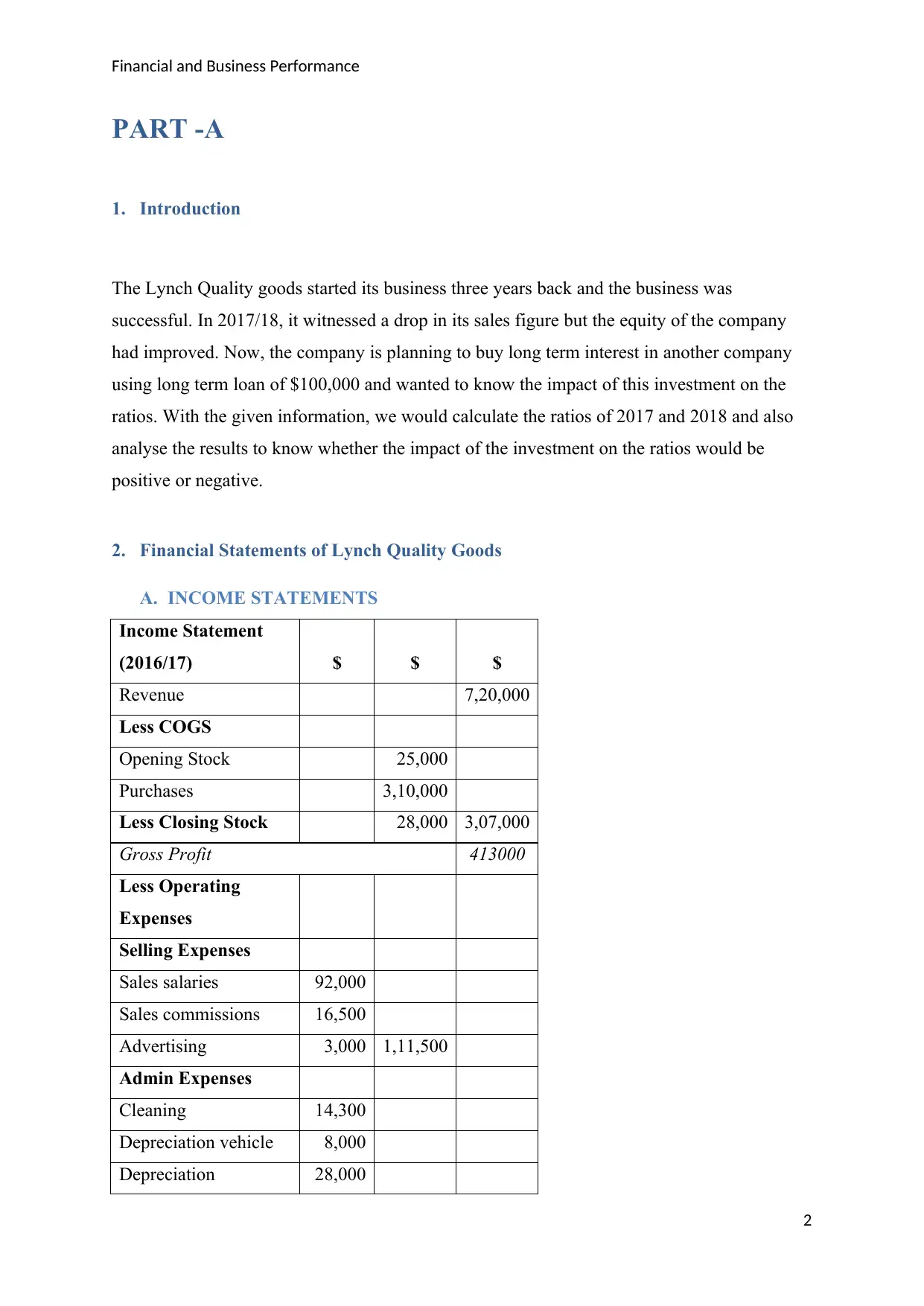
Financial and Business Performance
PART -A
1. Introduction
The Lynch Quality goods started its business three years back and the business was
successful. In 2017/18, it witnessed a drop in its sales figure but the equity of the company
had improved. Now, the company is planning to buy long term interest in another company
using long term loan of $100,000 and wanted to know the impact of this investment on the
ratios. With the given information, we would calculate the ratios of 2017 and 2018 and also
analyse the results to know whether the impact of the investment on the ratios would be
positive or negative.
2. Financial Statements of Lynch Quality Goods
A. INCOME STATEMENTS
Income Statement
(2016/17) $ $ $
Revenue 7,20,000
Less COGS
Opening Stock 25,000
Purchases 3,10,000
Less Closing Stock 28,000 3,07,000
Gross Profit 413000
Less Operating
Expenses
Selling Expenses
Sales salaries 92,000
Sales commissions 16,500
Advertising 3,000 1,11,500
Admin Expenses
Cleaning 14,300
Depreciation vehicle 8,000
Depreciation 28,000
2
PART -A
1. Introduction
The Lynch Quality goods started its business three years back and the business was
successful. In 2017/18, it witnessed a drop in its sales figure but the equity of the company
had improved. Now, the company is planning to buy long term interest in another company
using long term loan of $100,000 and wanted to know the impact of this investment on the
ratios. With the given information, we would calculate the ratios of 2017 and 2018 and also
analyse the results to know whether the impact of the investment on the ratios would be
positive or negative.
2. Financial Statements of Lynch Quality Goods
A. INCOME STATEMENTS
Income Statement
(2016/17) $ $ $
Revenue 7,20,000
Less COGS
Opening Stock 25,000
Purchases 3,10,000
Less Closing Stock 28,000 3,07,000
Gross Profit 413000
Less Operating
Expenses
Selling Expenses
Sales salaries 92,000
Sales commissions 16,500
Advertising 3,000 1,11,500
Admin Expenses
Cleaning 14,300
Depreciation vehicle 8,000
Depreciation 28,000
2
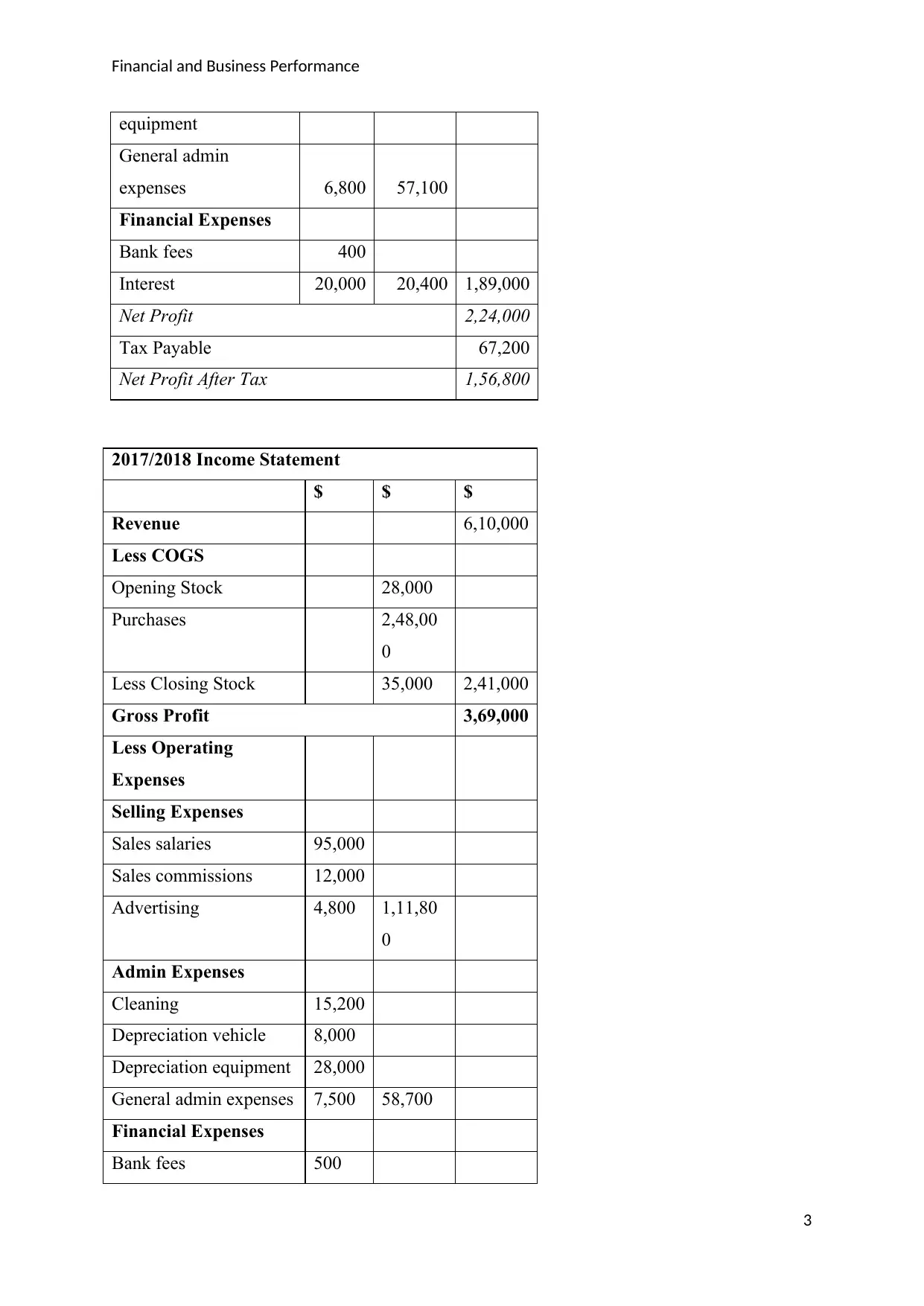
Financial and Business Performance
equipment
General admin
expenses 6,800 57,100
Financial Expenses
Bank fees 400
Interest 20,000 20,400 1,89,000
Net Profit 2,24,000
Tax Payable 67,200
Net Profit After Tax 1,56,800
2017/2018 Income Statement
$ $ $
Revenue 6,10,000
Less COGS
Opening Stock 28,000
Purchases 2,48,00
0
Less Closing Stock 35,000 2,41,000
Gross Profit 3,69,000
Less Operating
Expenses
Selling Expenses
Sales salaries 95,000
Sales commissions 12,000
Advertising 4,800 1,11,80
0
Admin Expenses
Cleaning 15,200
Depreciation vehicle 8,000
Depreciation equipment 28,000
General admin expenses 7,500 58,700
Financial Expenses
Bank fees 500
3
equipment
General admin
expenses 6,800 57,100
Financial Expenses
Bank fees 400
Interest 20,000 20,400 1,89,000
Net Profit 2,24,000
Tax Payable 67,200
Net Profit After Tax 1,56,800
2017/2018 Income Statement
$ $ $
Revenue 6,10,000
Less COGS
Opening Stock 28,000
Purchases 2,48,00
0
Less Closing Stock 35,000 2,41,000
Gross Profit 3,69,000
Less Operating
Expenses
Selling Expenses
Sales salaries 95,000
Sales commissions 12,000
Advertising 4,800 1,11,80
0
Admin Expenses
Cleaning 15,200
Depreciation vehicle 8,000
Depreciation equipment 28,000
General admin expenses 7,500 58,700
Financial Expenses
Bank fees 500
3
Secure Best Marks with AI Grader
Need help grading? Try our AI Grader for instant feedback on your assignments.
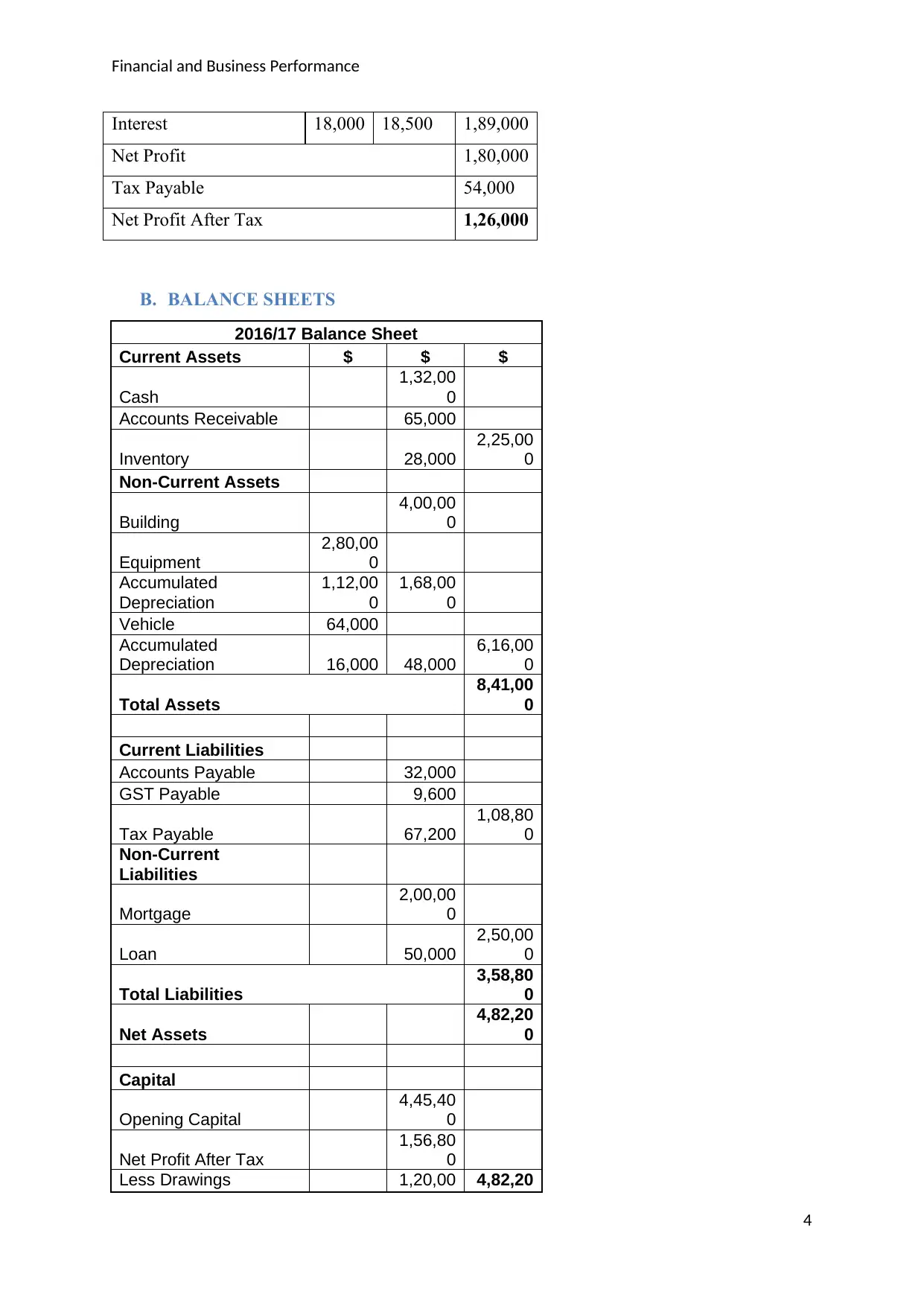
Financial and Business Performance
Interest 18,000 18,500 1,89,000
Net Profit 1,80,000
Tax Payable 54,000
Net Profit After Tax 1,26,000
B. BALANCE SHEETS
2016/17 Balance Sheet
Current Assets $ $ $
Cash
1,32,00
0
Accounts Receivable 65,000
Inventory 28,000
2,25,00
0
Non-Current Assets
Building
4,00,00
0
Equipment
2,80,00
0
Accumulated
Depreciation
1,12,00
0
1,68,00
0
Vehicle 64,000
Accumulated
Depreciation 16,000 48,000
6,16,00
0
Total Assets
8,41,00
0
Current Liabilities
Accounts Payable 32,000
GST Payable 9,600
Tax Payable 67,200
1,08,80
0
Non-Current
Liabilities
Mortgage
2,00,00
0
Loan 50,000
2,50,00
0
Total Liabilities
3,58,80
0
Net Assets
4,82,20
0
Capital
Opening Capital
4,45,40
0
Net Profit After Tax
1,56,80
0
Less Drawings 1,20,00 4,82,20
4
Interest 18,000 18,500 1,89,000
Net Profit 1,80,000
Tax Payable 54,000
Net Profit After Tax 1,26,000
B. BALANCE SHEETS
2016/17 Balance Sheet
Current Assets $ $ $
Cash
1,32,00
0
Accounts Receivable 65,000
Inventory 28,000
2,25,00
0
Non-Current Assets
Building
4,00,00
0
Equipment
2,80,00
0
Accumulated
Depreciation
1,12,00
0
1,68,00
0
Vehicle 64,000
Accumulated
Depreciation 16,000 48,000
6,16,00
0
Total Assets
8,41,00
0
Current Liabilities
Accounts Payable 32,000
GST Payable 9,600
Tax Payable 67,200
1,08,80
0
Non-Current
Liabilities
Mortgage
2,00,00
0
Loan 50,000
2,50,00
0
Total Liabilities
3,58,80
0
Net Assets
4,82,20
0
Capital
Opening Capital
4,45,40
0
Net Profit After Tax
1,56,80
0
Less Drawings 1,20,00 4,82,20
4
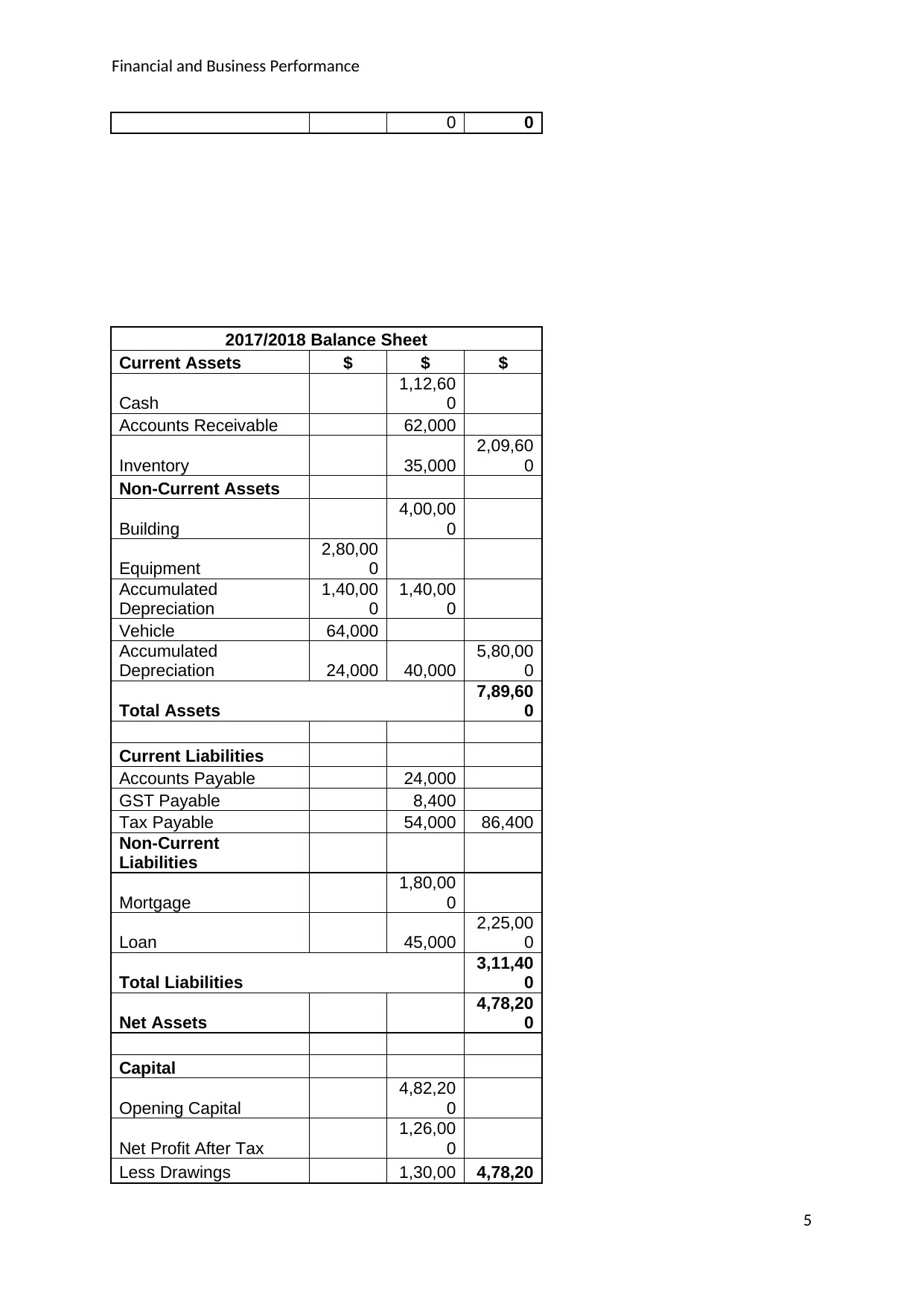
Financial and Business Performance
0 0
2017/2018 Balance Sheet
Current Assets $ $ $
Cash
1,12,60
0
Accounts Receivable 62,000
Inventory 35,000
2,09,60
0
Non-Current Assets
Building
4,00,00
0
Equipment
2,80,00
0
Accumulated
Depreciation
1,40,00
0
1,40,00
0
Vehicle 64,000
Accumulated
Depreciation 24,000 40,000
5,80,00
0
Total Assets
7,89,60
0
Current Liabilities
Accounts Payable 24,000
GST Payable 8,400
Tax Payable 54,000 86,400
Non-Current
Liabilities
Mortgage
1,80,00
0
Loan 45,000
2,25,00
0
Total Liabilities
3,11,40
0
Net Assets
4,78,20
0
Capital
Opening Capital
4,82,20
0
Net Profit After Tax
1,26,00
0
Less Drawings 1,30,00 4,78,20
5
0 0
2017/2018 Balance Sheet
Current Assets $ $ $
Cash
1,12,60
0
Accounts Receivable 62,000
Inventory 35,000
2,09,60
0
Non-Current Assets
Building
4,00,00
0
Equipment
2,80,00
0
Accumulated
Depreciation
1,40,00
0
1,40,00
0
Vehicle 64,000
Accumulated
Depreciation 24,000 40,000
5,80,00
0
Total Assets
7,89,60
0
Current Liabilities
Accounts Payable 24,000
GST Payable 8,400
Tax Payable 54,000 86,400
Non-Current
Liabilities
Mortgage
1,80,00
0
Loan 45,000
2,25,00
0
Total Liabilities
3,11,40
0
Net Assets
4,78,20
0
Capital
Opening Capital
4,82,20
0
Net Profit After Tax
1,26,00
0
Less Drawings 1,30,00 4,78,20
5
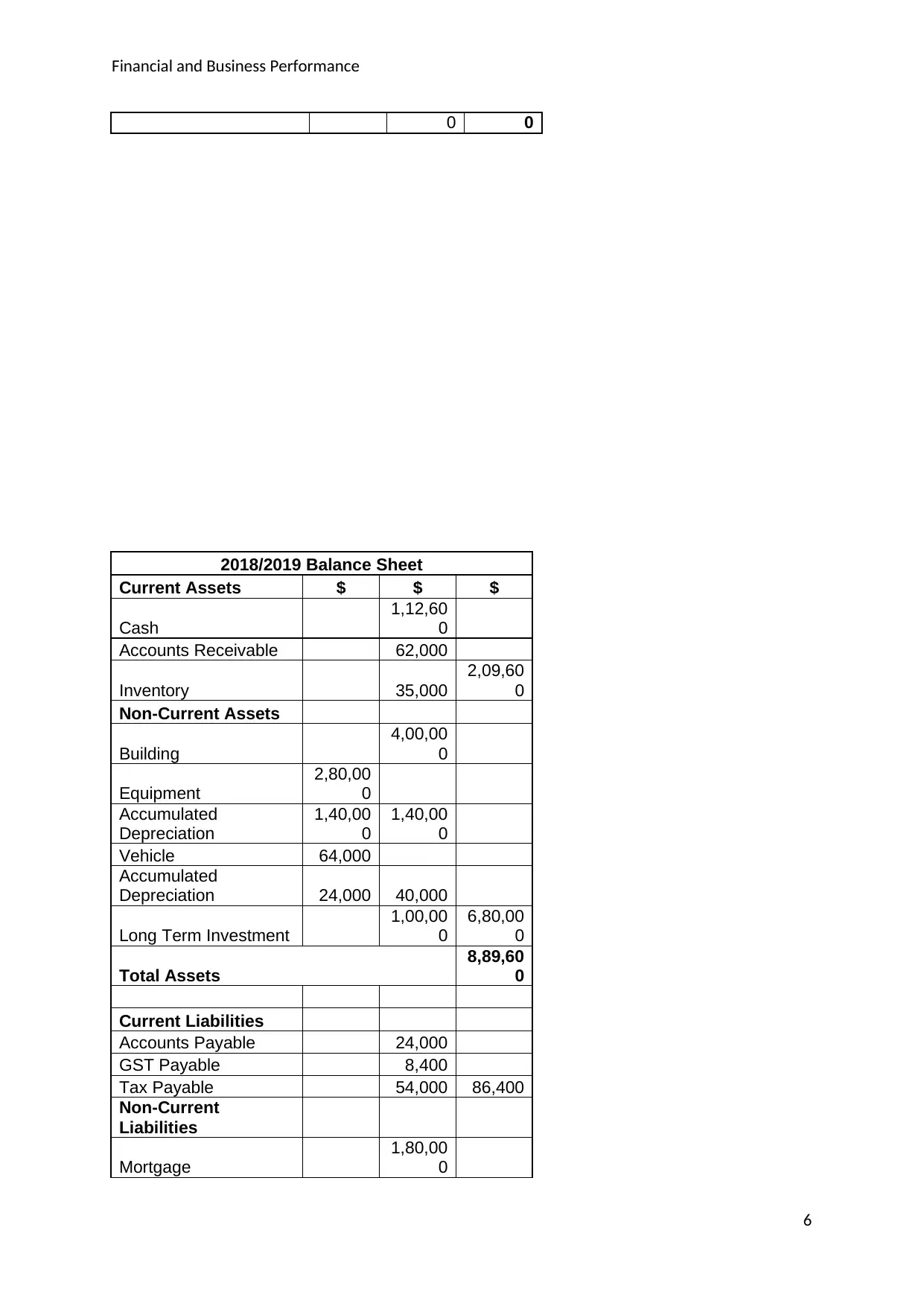
Financial and Business Performance
0 0
2018/2019 Balance Sheet
Current Assets $ $ $
Cash
1,12,60
0
Accounts Receivable 62,000
Inventory 35,000
2,09,60
0
Non-Current Assets
Building
4,00,00
0
Equipment
2,80,00
0
Accumulated
Depreciation
1,40,00
0
1,40,00
0
Vehicle 64,000
Accumulated
Depreciation 24,000 40,000
Long Term Investment
1,00,00
0
6,80,00
0
Total Assets
8,89,60
0
Current Liabilities
Accounts Payable 24,000
GST Payable 8,400
Tax Payable 54,000 86,400
Non-Current
Liabilities
Mortgage
1,80,00
0
6
0 0
2018/2019 Balance Sheet
Current Assets $ $ $
Cash
1,12,60
0
Accounts Receivable 62,000
Inventory 35,000
2,09,60
0
Non-Current Assets
Building
4,00,00
0
Equipment
2,80,00
0
Accumulated
Depreciation
1,40,00
0
1,40,00
0
Vehicle 64,000
Accumulated
Depreciation 24,000 40,000
Long Term Investment
1,00,00
0
6,80,00
0
Total Assets
8,89,60
0
Current Liabilities
Accounts Payable 24,000
GST Payable 8,400
Tax Payable 54,000 86,400
Non-Current
Liabilities
Mortgage
1,80,00
0
6
Paraphrase This Document
Need a fresh take? Get an instant paraphrase of this document with our AI Paraphraser
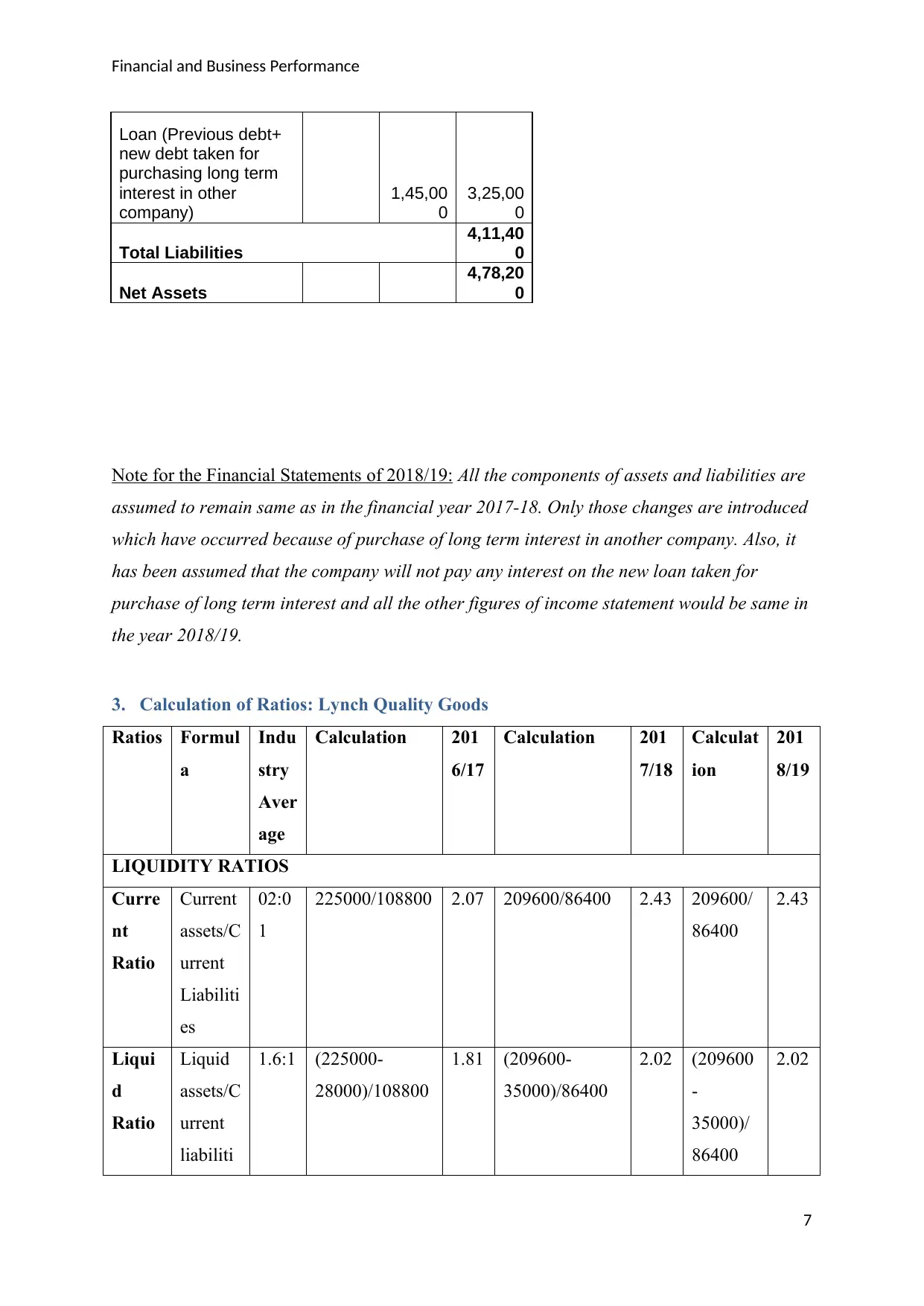
Financial and Business Performance
Loan (Previous debt+
new debt taken for
purchasing long term
interest in other
company)
1,45,00
0
3,25,00
0
Total Liabilities
4,11,40
0
Net Assets
4,78,20
0
Note for the Financial Statements of 2018/19: All the components of assets and liabilities are
assumed to remain same as in the financial year 2017-18. Only those changes are introduced
which have occurred because of purchase of long term interest in another company. Also, it
has been assumed that the company will not pay any interest on the new loan taken for
purchase of long term interest and all the other figures of income statement would be same in
the year 2018/19.
3. Calculation of Ratios: Lynch Quality Goods
Ratios Formul
a
Indu
stry
Aver
age
Calculation 201
6/17
Calculation 201
7/18
Calculat
ion
201
8/19
LIQUIDITY RATIOS
Curre
nt
Ratio
Current
assets/C
urrent
Liabiliti
es
02:0
1
225000/108800 2.07 209600/86400 2.43 209600/
86400
2.43
Liqui
d
Ratio
Liquid
assets/C
urrent
liabiliti
1.6:1 (225000-
28000)/108800
1.81 (209600-
35000)/86400
2.02 (209600
-
35000)/
86400
2.02
7
Loan (Previous debt+
new debt taken for
purchasing long term
interest in other
company)
1,45,00
0
3,25,00
0
Total Liabilities
4,11,40
0
Net Assets
4,78,20
0
Note for the Financial Statements of 2018/19: All the components of assets and liabilities are
assumed to remain same as in the financial year 2017-18. Only those changes are introduced
which have occurred because of purchase of long term interest in another company. Also, it
has been assumed that the company will not pay any interest on the new loan taken for
purchase of long term interest and all the other figures of income statement would be same in
the year 2018/19.
3. Calculation of Ratios: Lynch Quality Goods
Ratios Formul
a
Indu
stry
Aver
age
Calculation 201
6/17
Calculation 201
7/18
Calculat
ion
201
8/19
LIQUIDITY RATIOS
Curre
nt
Ratio
Current
assets/C
urrent
Liabiliti
es
02:0
1
225000/108800 2.07 209600/86400 2.43 209600/
86400
2.43
Liqui
d
Ratio
Liquid
assets/C
urrent
liabiliti
1.6:1 (225000-
28000)/108800
1.81 (209600-
35000)/86400
2.02 (209600
-
35000)/
86400
2.02
7
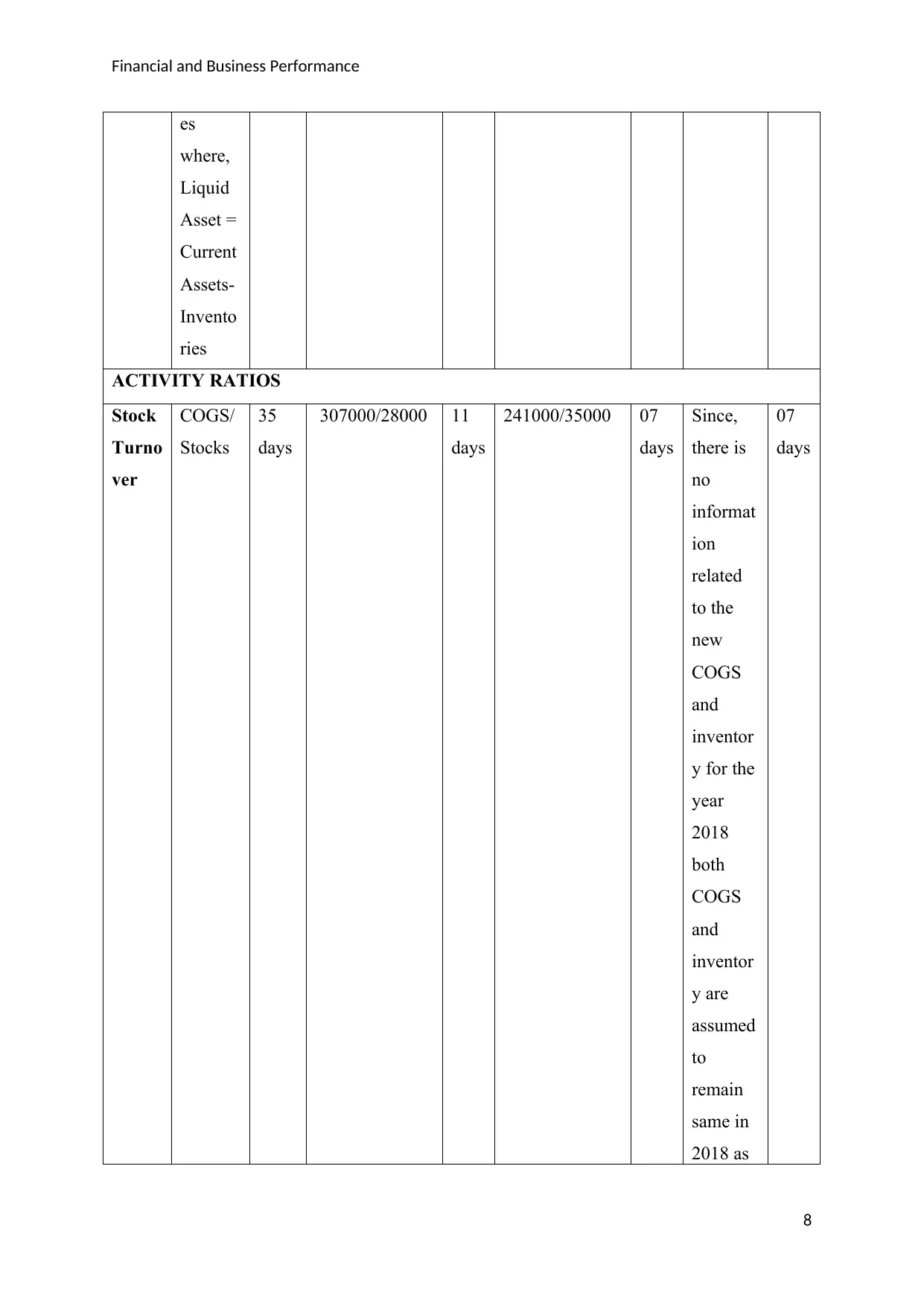
Financial and Business Performance
es
where,
Liquid
Asset =
Current
Assets-
Invento
ries
ACTIVITY RATIOS
Stock
Turno
ver
COGS/
Stocks
35
days
307000/28000 11
days
241000/35000 07
days
Since,
there is
no
informat
ion
related
to the
new
COGS
and
inventor
y for the
year
2018
both
COGS
and
inventor
y are
assumed
to
remain
same in
2018 as
07
days
8
es
where,
Liquid
Asset =
Current
Assets-
Invento
ries
ACTIVITY RATIOS
Stock
Turno
ver
COGS/
Stocks
35
days
307000/28000 11
days
241000/35000 07
days
Since,
there is
no
informat
ion
related
to the
new
COGS
and
inventor
y for the
year
2018
both
COGS
and
inventor
y are
assumed
to
remain
same in
2018 as
07
days
8
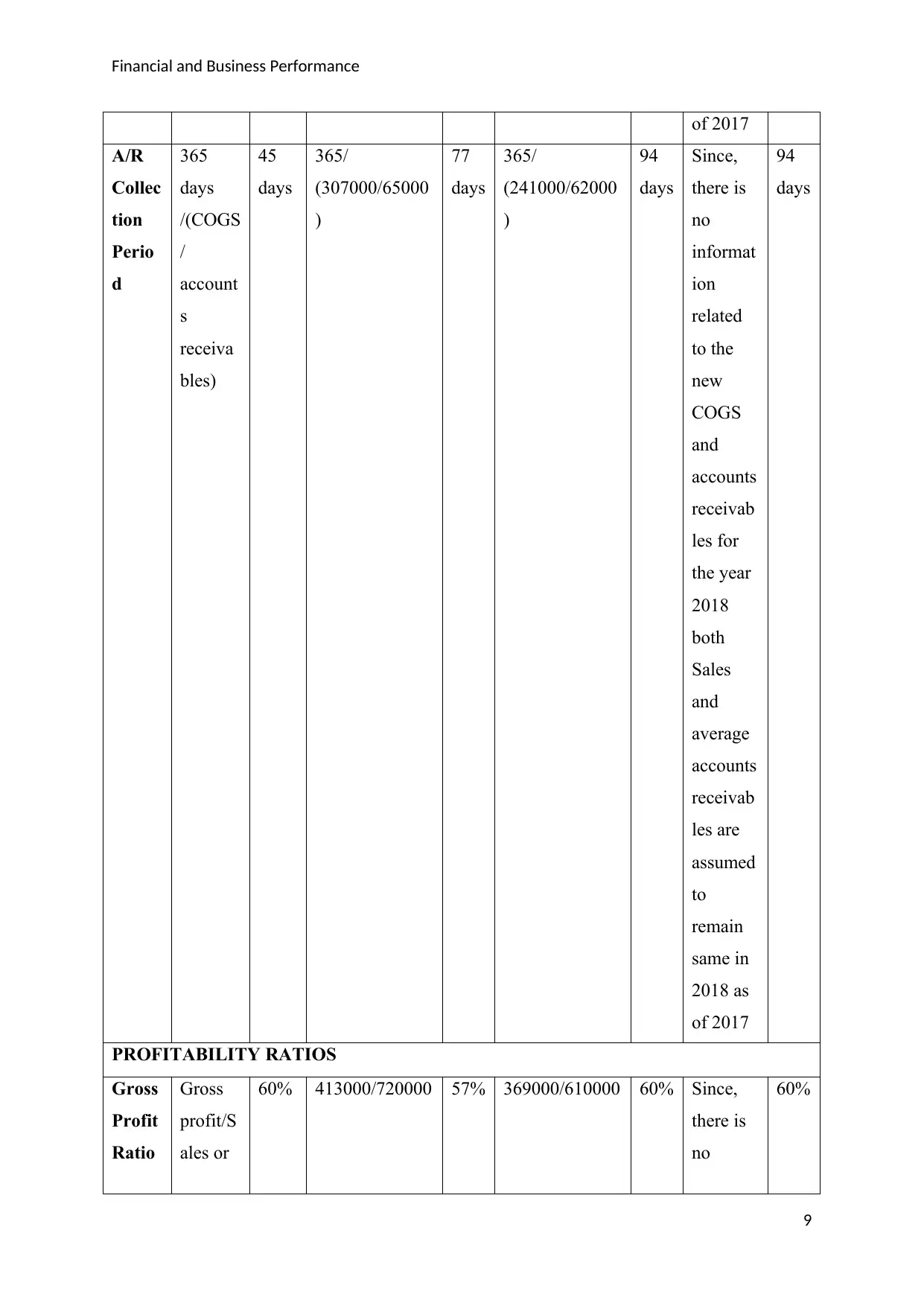
Financial and Business Performance
of 2017
A/R
Collec
tion
Perio
d
365
days
/(COGS
/
account
s
receiva
bles)
45
days
365/
(307000/65000
)
77
days
365/
(241000/62000
)
94
days
Since,
there is
no
informat
ion
related
to the
new
COGS
and
accounts
receivab
les for
the year
2018
both
Sales
and
average
accounts
receivab
les are
assumed
to
remain
same in
2018 as
of 2017
94
days
PROFITABILITY RATIOS
Gross
Profit
Ratio
Gross
profit/S
ales or
60% 413000/720000 57% 369000/610000 60% Since,
there is
no
60%
9
of 2017
A/R
Collec
tion
Perio
d
365
days
/(COGS
/
account
s
receiva
bles)
45
days
365/
(307000/65000
)
77
days
365/
(241000/62000
)
94
days
Since,
there is
no
informat
ion
related
to the
new
COGS
and
accounts
receivab
les for
the year
2018
both
Sales
and
average
accounts
receivab
les are
assumed
to
remain
same in
2018 as
of 2017
94
days
PROFITABILITY RATIOS
Gross
Profit
Ratio
Gross
profit/S
ales or
60% 413000/720000 57% 369000/610000 60% Since,
there is
no
60%
9
Secure Best Marks with AI Grader
Need help grading? Try our AI Grader for instant feedback on your assignments.
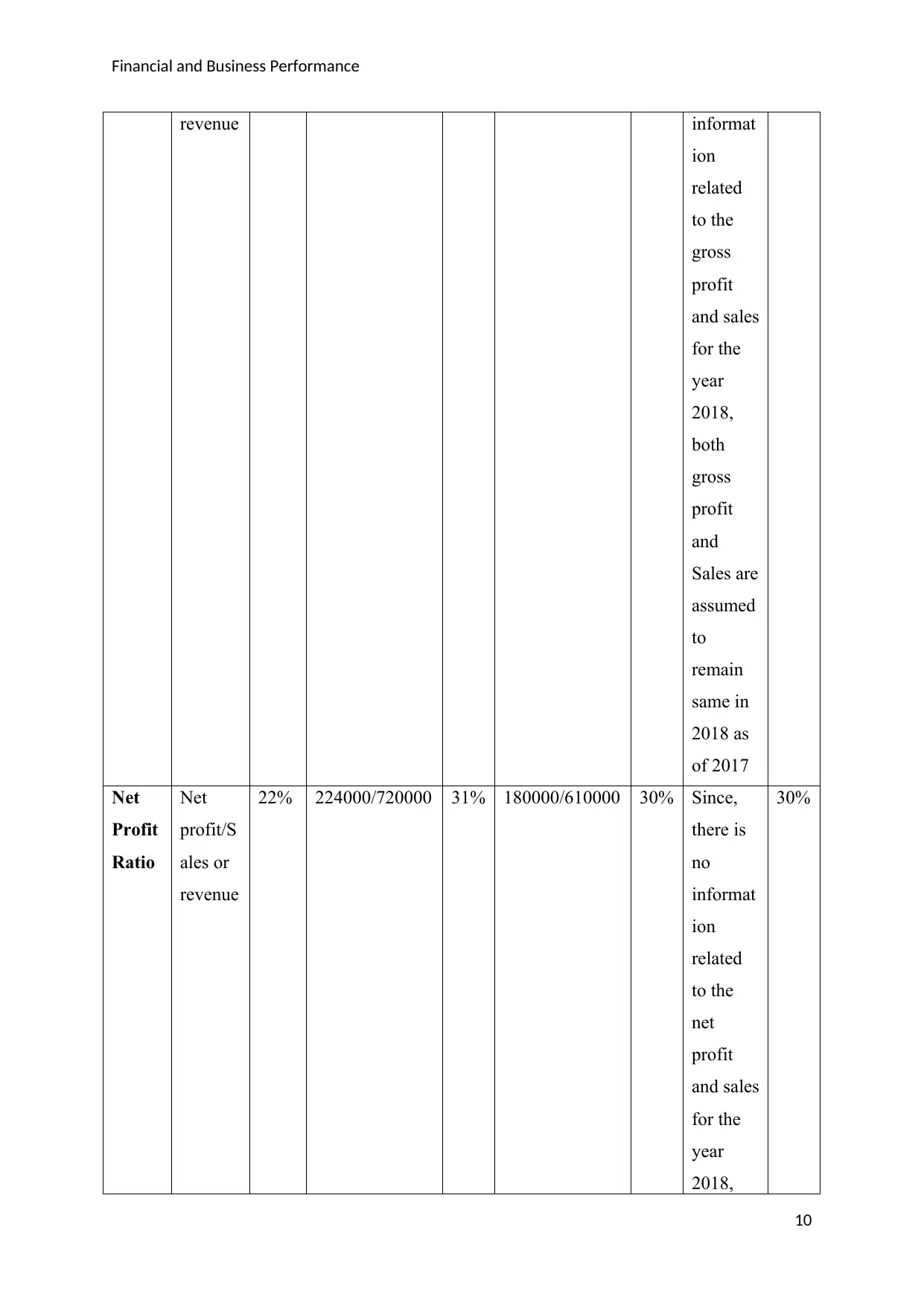
Financial and Business Performance
revenue informat
ion
related
to the
gross
profit
and sales
for the
year
2018,
both
gross
profit
and
Sales are
assumed
to
remain
same in
2018 as
of 2017
Net
Profit
Ratio
Net
profit/S
ales or
revenue
22% 224000/720000 31% 180000/610000 30% Since,
there is
no
informat
ion
related
to the
net
profit
and sales
for the
year
2018,
30%
10
revenue informat
ion
related
to the
gross
profit
and sales
for the
year
2018,
both
gross
profit
and
Sales are
assumed
to
remain
same in
2018 as
of 2017
Net
Profit
Ratio
Net
profit/S
ales or
revenue
22% 224000/720000 31% 180000/610000 30% Since,
there is
no
informat
ion
related
to the
net
profit
and sales
for the
year
2018,
30%
10
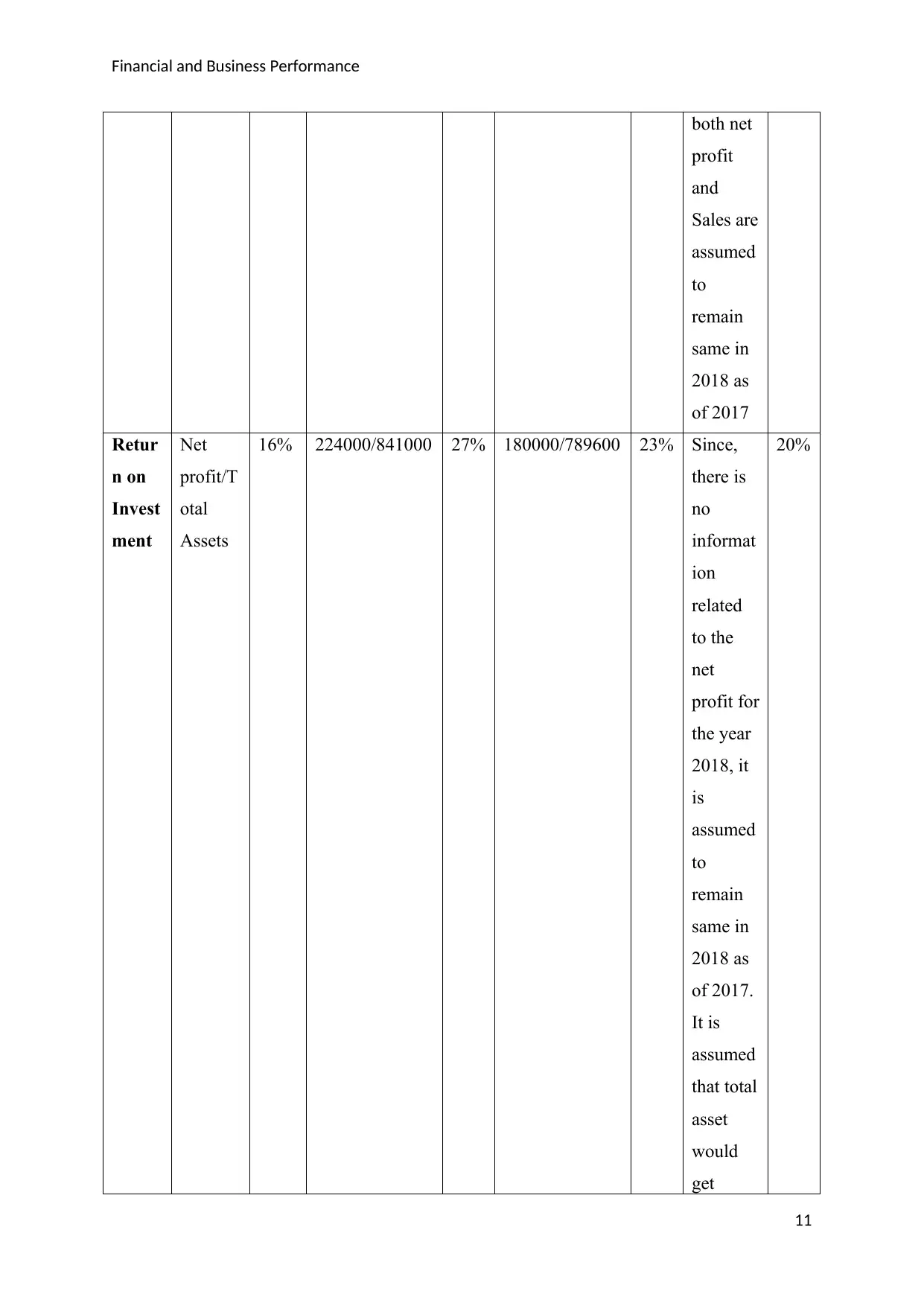
Financial and Business Performance
both net
profit
and
Sales are
assumed
to
remain
same in
2018 as
of 2017
Retur
n on
Invest
ment
Net
profit/T
otal
Assets
16% 224000/841000 27% 180000/789600 23% Since,
there is
no
informat
ion
related
to the
net
profit for
the year
2018, it
is
assumed
to
remain
same in
2018 as
of 2017.
It is
assumed
that total
asset
would
get
20%
11
both net
profit
and
Sales are
assumed
to
remain
same in
2018 as
of 2017
Retur
n on
Invest
ment
Net
profit/T
otal
Assets
16% 224000/841000 27% 180000/789600 23% Since,
there is
no
informat
ion
related
to the
net
profit for
the year
2018, it
is
assumed
to
remain
same in
2018 as
of 2017.
It is
assumed
that total
asset
would
get
20%
11
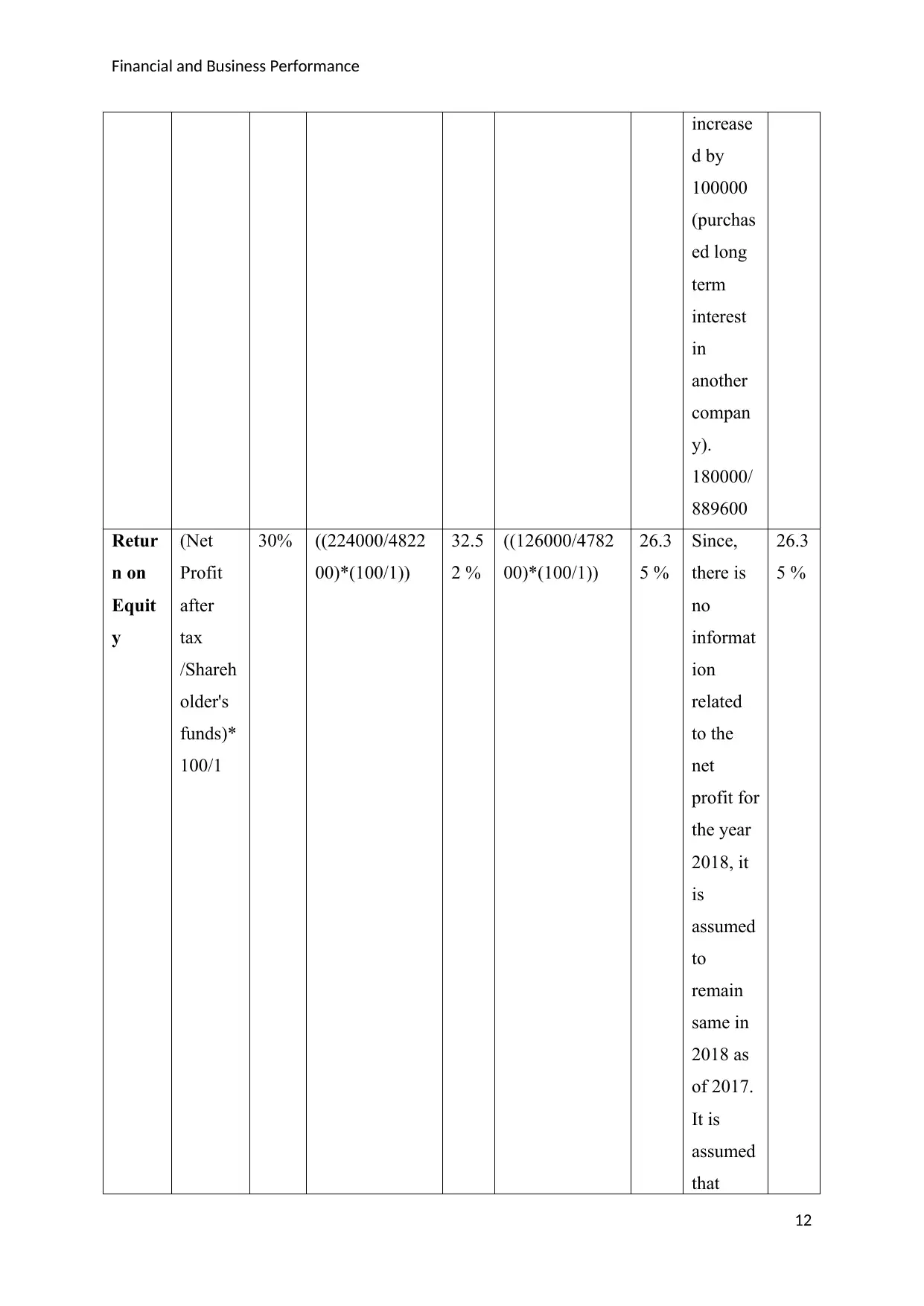
Financial and Business Performance
increase
d by
100000
(purchas
ed long
term
interest
in
another
compan
y).
180000/
889600
Retur
n on
Equit
y
(Net
Profit
after
tax
/Shareh
older's
funds)*
100/1
30% ((224000/4822
00)*(100/1))
32.5
2 %
((126000/4782
00)*(100/1))
26.3
5 %
Since,
there is
no
informat
ion
related
to the
net
profit for
the year
2018, it
is
assumed
to
remain
same in
2018 as
of 2017.
It is
assumed
that
26.3
5 %
12
increase
d by
100000
(purchas
ed long
term
interest
in
another
compan
y).
180000/
889600
Retur
n on
Equit
y
(Net
Profit
after
tax
/Shareh
older's
funds)*
100/1
30% ((224000/4822
00)*(100/1))
32.5
2 %
((126000/4782
00)*(100/1))
26.3
5 %
Since,
there is
no
informat
ion
related
to the
net
profit for
the year
2018, it
is
assumed
to
remain
same in
2018 as
of 2017.
It is
assumed
that
26.3
5 %
12
Paraphrase This Document
Need a fresh take? Get an instant paraphrase of this document with our AI Paraphraser
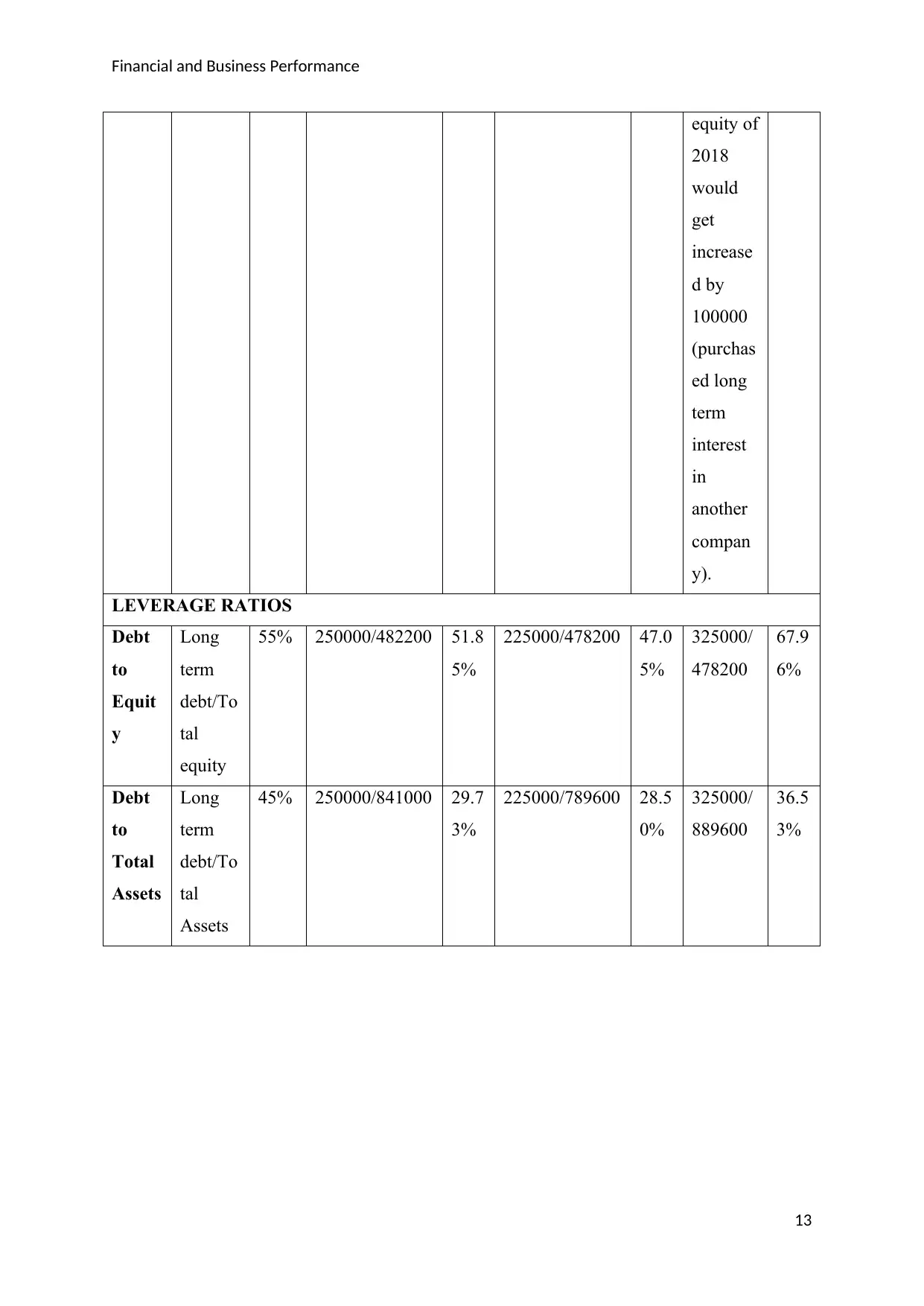
Financial and Business Performance
equity of
2018
would
get
increase
d by
100000
(purchas
ed long
term
interest
in
another
compan
y).
LEVERAGE RATIOS
Debt
to
Equit
y
Long
term
debt/To
tal
equity
55% 250000/482200 51.8
5%
225000/478200 47.0
5%
325000/
478200
67.9
6%
Debt
to
Total
Assets
Long
term
debt/To
tal
Assets
45% 250000/841000 29.7
3%
225000/789600 28.5
0%
325000/
889600
36.5
3%
13
equity of
2018
would
get
increase
d by
100000
(purchas
ed long
term
interest
in
another
compan
y).
LEVERAGE RATIOS
Debt
to
Equit
y
Long
term
debt/To
tal
equity
55% 250000/482200 51.8
5%
225000/478200 47.0
5%
325000/
478200
67.9
6%
Debt
to
Total
Assets
Long
term
debt/To
tal
Assets
45% 250000/841000 29.7
3%
225000/789600 28.5
0%
325000/
889600
36.5
3%
13
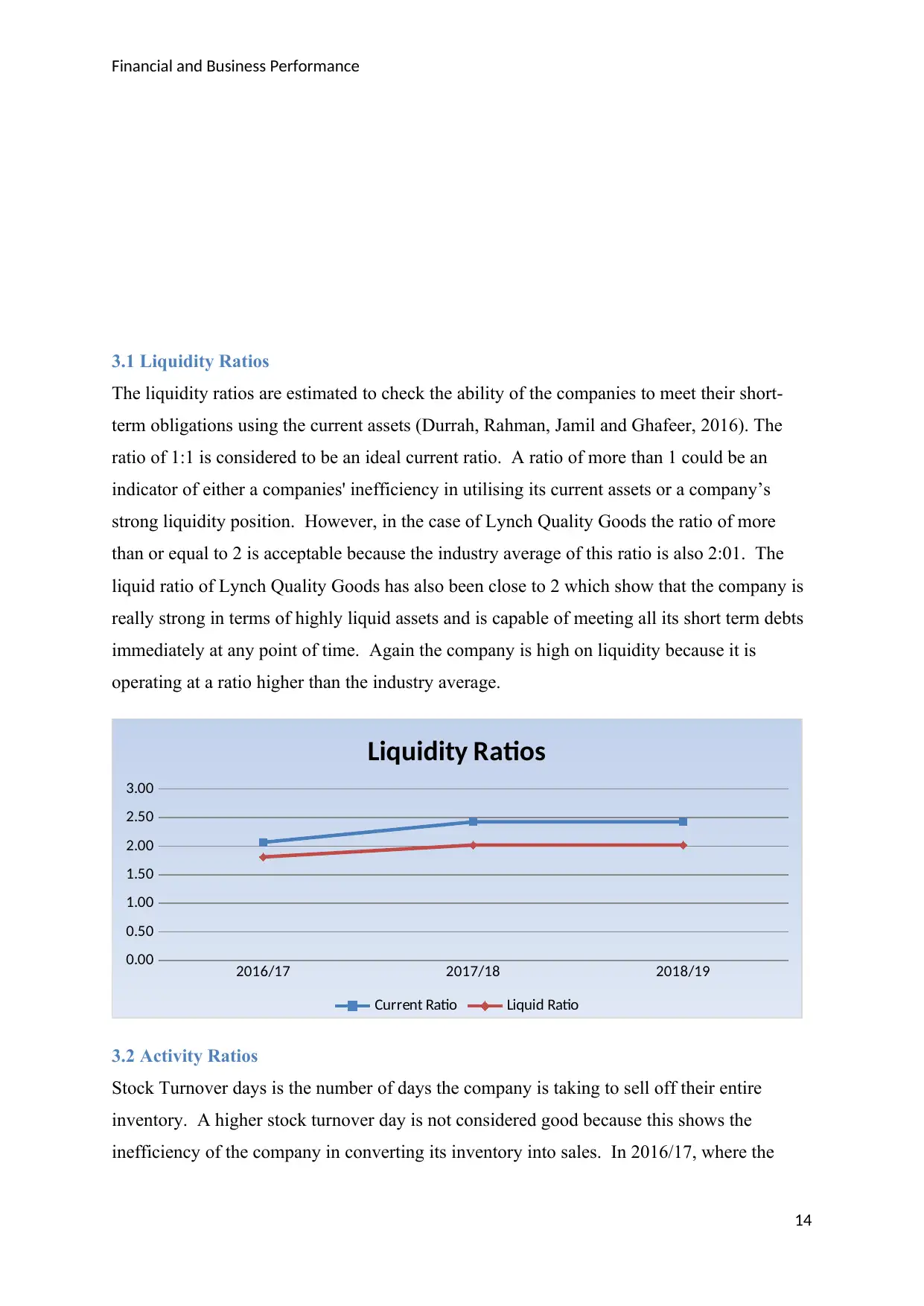
Financial and Business Performance
3.1 Liquidity Ratios
The liquidity ratios are estimated to check the ability of the companies to meet their short-
term obligations using the current assets (Durrah, Rahman, Jamil and Ghafeer, 2016). The
ratio of 1:1 is considered to be an ideal current ratio. A ratio of more than 1 could be an
indicator of either a companies' inefficiency in utilising its current assets or a company’s
strong liquidity position. However, in the case of Lynch Quality Goods the ratio of more
than or equal to 2 is acceptable because the industry average of this ratio is also 2:01. The
liquid ratio of Lynch Quality Goods has also been close to 2 which show that the company is
really strong in terms of highly liquid assets and is capable of meeting all its short term debts
immediately at any point of time. Again the company is high on liquidity because it is
operating at a ratio higher than the industry average.
2016/17 2017/18 2018/19
0.00
0.50
1.00
1.50
2.00
2.50
3.00
Liquidity Ratios
Current Ratio Liquid Ratio
3.2 Activity Ratios
Stock Turnover days is the number of days the company is taking to sell off their entire
inventory. A higher stock turnover day is not considered good because this shows the
inefficiency of the company in converting its inventory into sales. In 2016/17, where the
14
3.1 Liquidity Ratios
The liquidity ratios are estimated to check the ability of the companies to meet their short-
term obligations using the current assets (Durrah, Rahman, Jamil and Ghafeer, 2016). The
ratio of 1:1 is considered to be an ideal current ratio. A ratio of more than 1 could be an
indicator of either a companies' inefficiency in utilising its current assets or a company’s
strong liquidity position. However, in the case of Lynch Quality Goods the ratio of more
than or equal to 2 is acceptable because the industry average of this ratio is also 2:01. The
liquid ratio of Lynch Quality Goods has also been close to 2 which show that the company is
really strong in terms of highly liquid assets and is capable of meeting all its short term debts
immediately at any point of time. Again the company is high on liquidity because it is
operating at a ratio higher than the industry average.
2016/17 2017/18 2018/19
0.00
0.50
1.00
1.50
2.00
2.50
3.00
Liquidity Ratios
Current Ratio Liquid Ratio
3.2 Activity Ratios
Stock Turnover days is the number of days the company is taking to sell off their entire
inventory. A higher stock turnover day is not considered good because this shows the
inefficiency of the company in converting its inventory into sales. In 2016/17, where the
14
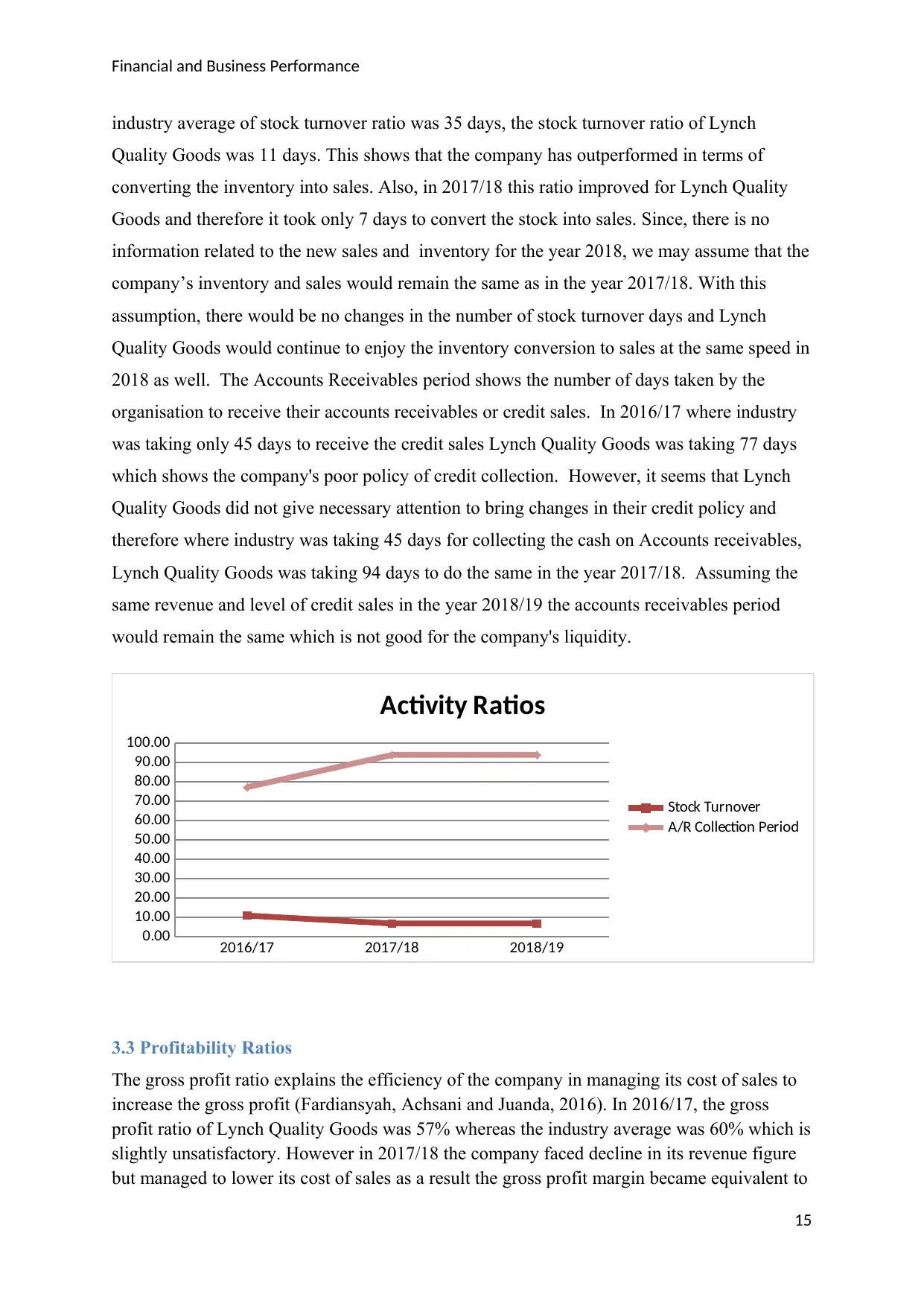
Financial and Business Performance
industry average of stock turnover ratio was 35 days, the stock turnover ratio of Lynch
Quality Goods was 11 days. This shows that the company has outperformed in terms of
converting the inventory into sales. Also, in 2017/18 this ratio improved for Lynch Quality
Goods and therefore it took only 7 days to convert the stock into sales. Since, there is no
information related to the new sales and inventory for the year 2018, we may assume that the
company’s inventory and sales would remain the same as in the year 2017/18. With this
assumption, there would be no changes in the number of stock turnover days and Lynch
Quality Goods would continue to enjoy the inventory conversion to sales at the same speed in
2018 as well. The Accounts Receivables period shows the number of days taken by the
organisation to receive their accounts receivables or credit sales. In 2016/17 where industry
was taking only 45 days to receive the credit sales Lynch Quality Goods was taking 77 days
which shows the company's poor policy of credit collection. However, it seems that Lynch
Quality Goods did not give necessary attention to bring changes in their credit policy and
therefore where industry was taking 45 days for collecting the cash on Accounts receivables,
Lynch Quality Goods was taking 94 days to do the same in the year 2017/18. Assuming the
same revenue and level of credit sales in the year 2018/19 the accounts receivables period
would remain the same which is not good for the company's liquidity.
2016/17 2017/18 2018/19
0.00
10.00
20.00
30.00
40.00
50.00
60.00
70.00
80.00
90.00
100.00
Activity Ratios
Stock Turnover
A/R Collection Period
3.3 Profitability Ratios
The gross profit ratio explains the efficiency of the company in managing its cost of sales to
increase the gross profit (Fardiansyah, Achsani and Juanda, 2016). In 2016/17, the gross
profit ratio of Lynch Quality Goods was 57% whereas the industry average was 60% which is
slightly unsatisfactory. However in 2017/18 the company faced decline in its revenue figure
but managed to lower its cost of sales as a result the gross profit margin became equivalent to
15
industry average of stock turnover ratio was 35 days, the stock turnover ratio of Lynch
Quality Goods was 11 days. This shows that the company has outperformed in terms of
converting the inventory into sales. Also, in 2017/18 this ratio improved for Lynch Quality
Goods and therefore it took only 7 days to convert the stock into sales. Since, there is no
information related to the new sales and inventory for the year 2018, we may assume that the
company’s inventory and sales would remain the same as in the year 2017/18. With this
assumption, there would be no changes in the number of stock turnover days and Lynch
Quality Goods would continue to enjoy the inventory conversion to sales at the same speed in
2018 as well. The Accounts Receivables period shows the number of days taken by the
organisation to receive their accounts receivables or credit sales. In 2016/17 where industry
was taking only 45 days to receive the credit sales Lynch Quality Goods was taking 77 days
which shows the company's poor policy of credit collection. However, it seems that Lynch
Quality Goods did not give necessary attention to bring changes in their credit policy and
therefore where industry was taking 45 days for collecting the cash on Accounts receivables,
Lynch Quality Goods was taking 94 days to do the same in the year 2017/18. Assuming the
same revenue and level of credit sales in the year 2018/19 the accounts receivables period
would remain the same which is not good for the company's liquidity.
2016/17 2017/18 2018/19
0.00
10.00
20.00
30.00
40.00
50.00
60.00
70.00
80.00
90.00
100.00
Activity Ratios
Stock Turnover
A/R Collection Period
3.3 Profitability Ratios
The gross profit ratio explains the efficiency of the company in managing its cost of sales to
increase the gross profit (Fardiansyah, Achsani and Juanda, 2016). In 2016/17, the gross
profit ratio of Lynch Quality Goods was 57% whereas the industry average was 60% which is
slightly unsatisfactory. However in 2017/18 the company faced decline in its revenue figure
but managed to lower its cost of sales as a result the gross profit margin became equivalent to
15
Secure Best Marks with AI Grader
Need help grading? Try our AI Grader for instant feedback on your assignments.
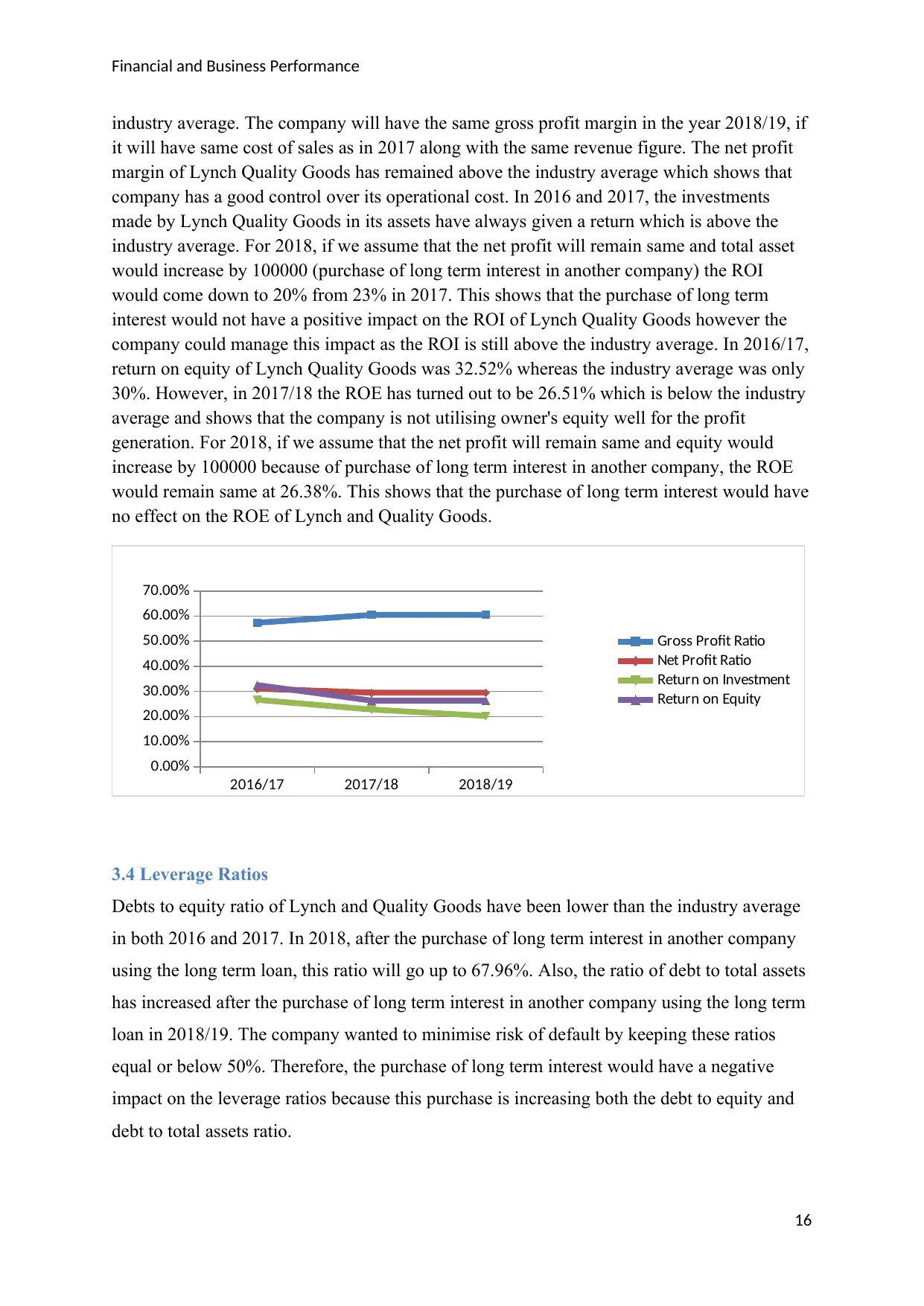
Financial and Business Performance
industry average. The company will have the same gross profit margin in the year 2018/19, if
it will have same cost of sales as in 2017 along with the same revenue figure. The net profit
margin of Lynch Quality Goods has remained above the industry average which shows that
company has a good control over its operational cost. In 2016 and 2017, the investments
made by Lynch Quality Goods in its assets have always given a return which is above the
industry average. For 2018, if we assume that the net profit will remain same and total asset
would increase by 100000 (purchase of long term interest in another company) the ROI
would come down to 20% from 23% in 2017. This shows that the purchase of long term
interest would not have a positive impact on the ROI of Lynch Quality Goods however the
company could manage this impact as the ROI is still above the industry average. In 2016/17,
return on equity of Lynch Quality Goods was 32.52% whereas the industry average was only
30%. However, in 2017/18 the ROE has turned out to be 26.51% which is below the industry
average and shows that the company is not utilising owner's equity well for the profit
generation. For 2018, if we assume that the net profit will remain same and equity would
increase by 100000 because of purchase of long term interest in another company, the ROE
would remain same at 26.38%. This shows that the purchase of long term interest would have
no effect on the ROE of Lynch and Quality Goods.
2016/17 2017/18 2018/19
0.00%
10.00%
20.00%
30.00%
40.00%
50.00%
60.00%
70.00%
Gross Profit Ratio
Net Profit Ratio
Return on Investment
Return on Equity
3.4 Leverage Ratios
Debts to equity ratio of Lynch and Quality Goods have been lower than the industry average
in both 2016 and 2017. In 2018, after the purchase of long term interest in another company
using the long term loan, this ratio will go up to 67.96%. Also, the ratio of debt to total assets
has increased after the purchase of long term interest in another company using the long term
loan in 2018/19. The company wanted to minimise risk of default by keeping these ratios
equal or below 50%. Therefore, the purchase of long term interest would have a negative
impact on the leverage ratios because this purchase is increasing both the debt to equity and
debt to total assets ratio.
16
industry average. The company will have the same gross profit margin in the year 2018/19, if
it will have same cost of sales as in 2017 along with the same revenue figure. The net profit
margin of Lynch Quality Goods has remained above the industry average which shows that
company has a good control over its operational cost. In 2016 and 2017, the investments
made by Lynch Quality Goods in its assets have always given a return which is above the
industry average. For 2018, if we assume that the net profit will remain same and total asset
would increase by 100000 (purchase of long term interest in another company) the ROI
would come down to 20% from 23% in 2017. This shows that the purchase of long term
interest would not have a positive impact on the ROI of Lynch Quality Goods however the
company could manage this impact as the ROI is still above the industry average. In 2016/17,
return on equity of Lynch Quality Goods was 32.52% whereas the industry average was only
30%. However, in 2017/18 the ROE has turned out to be 26.51% which is below the industry
average and shows that the company is not utilising owner's equity well for the profit
generation. For 2018, if we assume that the net profit will remain same and equity would
increase by 100000 because of purchase of long term interest in another company, the ROE
would remain same at 26.38%. This shows that the purchase of long term interest would have
no effect on the ROE of Lynch and Quality Goods.
2016/17 2017/18 2018/19
0.00%
10.00%
20.00%
30.00%
40.00%
50.00%
60.00%
70.00%
Gross Profit Ratio
Net Profit Ratio
Return on Investment
Return on Equity
3.4 Leverage Ratios
Debts to equity ratio of Lynch and Quality Goods have been lower than the industry average
in both 2016 and 2017. In 2018, after the purchase of long term interest in another company
using the long term loan, this ratio will go up to 67.96%. Also, the ratio of debt to total assets
has increased after the purchase of long term interest in another company using the long term
loan in 2018/19. The company wanted to minimise risk of default by keeping these ratios
equal or below 50%. Therefore, the purchase of long term interest would have a negative
impact on the leverage ratios because this purchase is increasing both the debt to equity and
debt to total assets ratio.
16
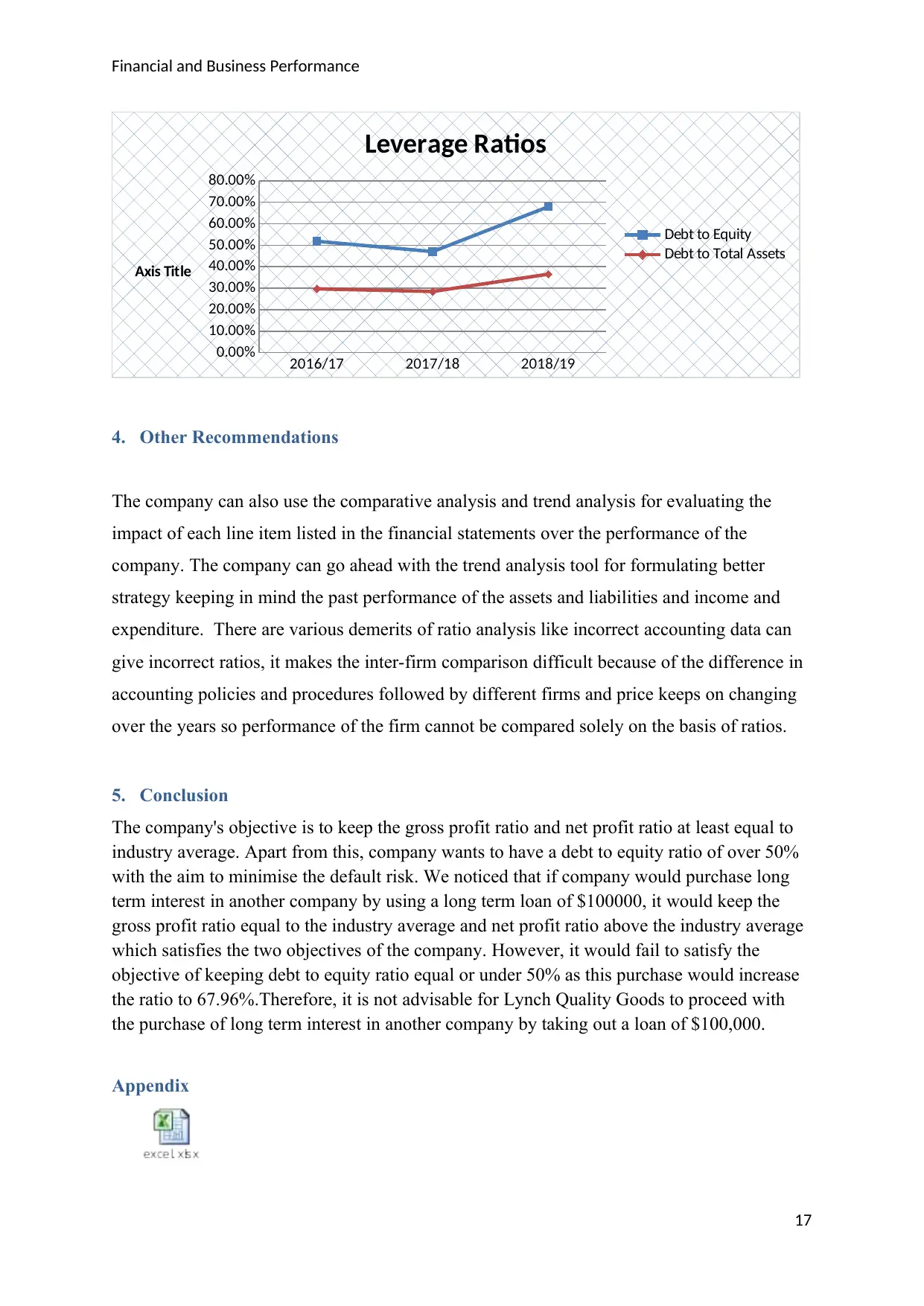
Financial and Business Performance
2016/17 2017/18 2018/19
0.00%
10.00%
20.00%
30.00%
40.00%
50.00%
60.00%
70.00%
80.00%
Leverage Ratios
Debt to Equity
Debt to Total Assets
Axis Title
4. Other Recommendations
The company can also use the comparative analysis and trend analysis for evaluating the
impact of each line item listed in the financial statements over the performance of the
company. The company can go ahead with the trend analysis tool for formulating better
strategy keeping in mind the past performance of the assets and liabilities and income and
expenditure. There are various demerits of ratio analysis like incorrect accounting data can
give incorrect ratios, it makes the inter-firm comparison difficult because of the difference in
accounting policies and procedures followed by different firms and price keeps on changing
over the years so performance of the firm cannot be compared solely on the basis of ratios.
5. Conclusion
The company's objective is to keep the gross profit ratio and net profit ratio at least equal to
industry average. Apart from this, company wants to have a debt to equity ratio of over 50%
with the aim to minimise the default risk. We noticed that if company would purchase long
term interest in another company by using a long term loan of $100000, it would keep the
gross profit ratio equal to the industry average and net profit ratio above the industry average
which satisfies the two objectives of the company. However, it would fail to satisfy the
objective of keeping debt to equity ratio equal or under 50% as this purchase would increase
the ratio to 67.96%.Therefore, it is not advisable for Lynch Quality Goods to proceed with
the purchase of long term interest in another company by taking out a loan of $100,000.
Appendix
17
2016/17 2017/18 2018/19
0.00%
10.00%
20.00%
30.00%
40.00%
50.00%
60.00%
70.00%
80.00%
Leverage Ratios
Debt to Equity
Debt to Total Assets
Axis Title
4. Other Recommendations
The company can also use the comparative analysis and trend analysis for evaluating the
impact of each line item listed in the financial statements over the performance of the
company. The company can go ahead with the trend analysis tool for formulating better
strategy keeping in mind the past performance of the assets and liabilities and income and
expenditure. There are various demerits of ratio analysis like incorrect accounting data can
give incorrect ratios, it makes the inter-firm comparison difficult because of the difference in
accounting policies and procedures followed by different firms and price keeps on changing
over the years so performance of the firm cannot be compared solely on the basis of ratios.
5. Conclusion
The company's objective is to keep the gross profit ratio and net profit ratio at least equal to
industry average. Apart from this, company wants to have a debt to equity ratio of over 50%
with the aim to minimise the default risk. We noticed that if company would purchase long
term interest in another company by using a long term loan of $100000, it would keep the
gross profit ratio equal to the industry average and net profit ratio above the industry average
which satisfies the two objectives of the company. However, it would fail to satisfy the
objective of keeping debt to equity ratio equal or under 50% as this purchase would increase
the ratio to 67.96%.Therefore, it is not advisable for Lynch Quality Goods to proceed with
the purchase of long term interest in another company by taking out a loan of $100,000.
Appendix
17
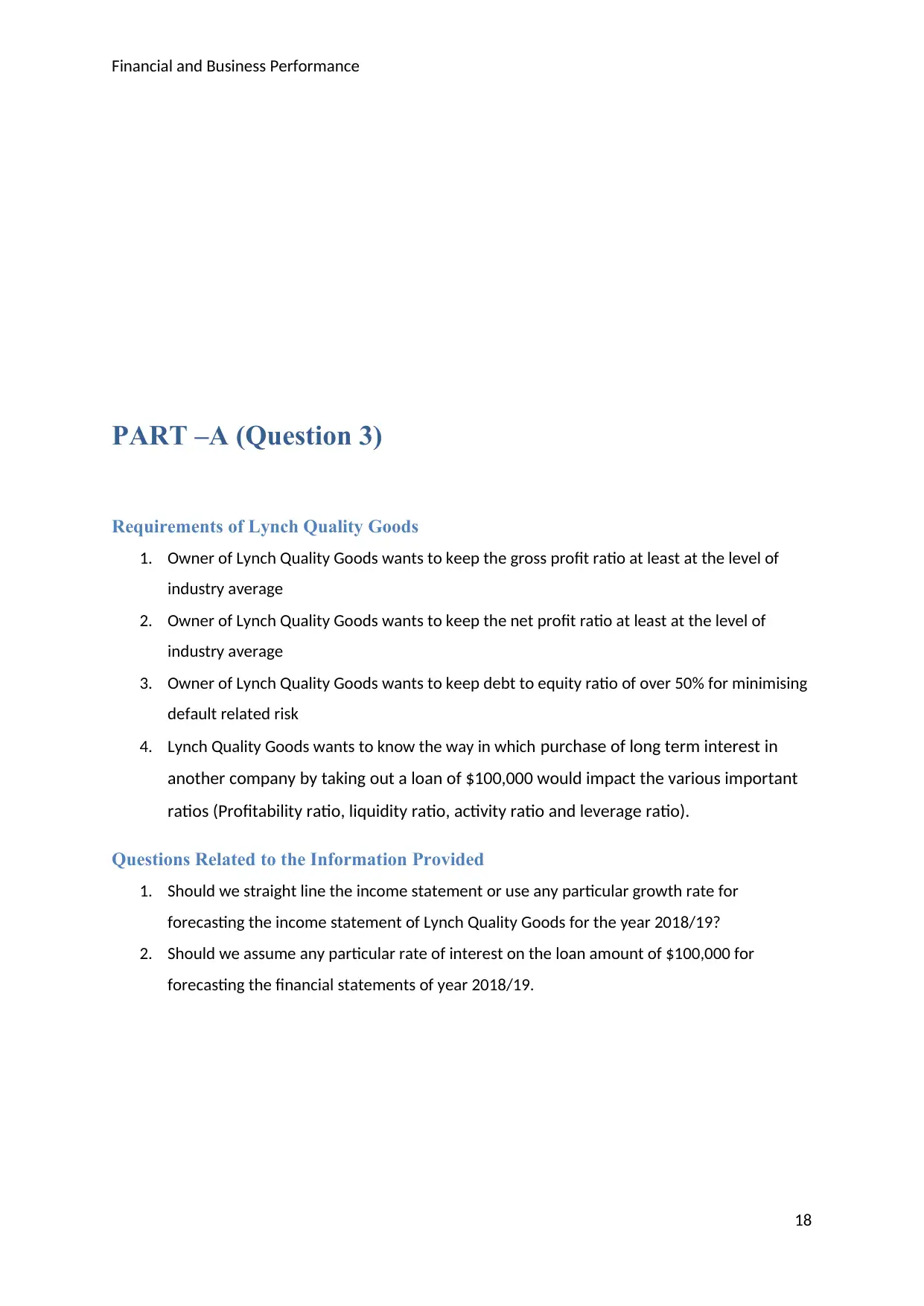
Financial and Business Performance
PART –A (Question 3)
Requirements of Lynch Quality Goods
1. Owner of Lynch Quality Goods wants to keep the gross profit ratio at least at the level of
industry average
2. Owner of Lynch Quality Goods wants to keep the net profit ratio at least at the level of
industry average
3. Owner of Lynch Quality Goods wants to keep debt to equity ratio of over 50% for minimising
default related risk
4. Lynch Quality Goods wants to know the way in which purchase of long term interest in
another company by taking out a loan of $100,000 would impact the various important
ratios (Profitability ratio, liquidity ratio, activity ratio and leverage ratio).
Questions Related to the Information Provided
1. Should we straight line the income statement or use any particular growth rate for
forecasting the income statement of Lynch Quality Goods for the year 2018/19?
2. Should we assume any particular rate of interest on the loan amount of $100,000 for
forecasting the financial statements of year 2018/19.
18
PART –A (Question 3)
Requirements of Lynch Quality Goods
1. Owner of Lynch Quality Goods wants to keep the gross profit ratio at least at the level of
industry average
2. Owner of Lynch Quality Goods wants to keep the net profit ratio at least at the level of
industry average
3. Owner of Lynch Quality Goods wants to keep debt to equity ratio of over 50% for minimising
default related risk
4. Lynch Quality Goods wants to know the way in which purchase of long term interest in
another company by taking out a loan of $100,000 would impact the various important
ratios (Profitability ratio, liquidity ratio, activity ratio and leverage ratio).
Questions Related to the Information Provided
1. Should we straight line the income statement or use any particular growth rate for
forecasting the income statement of Lynch Quality Goods for the year 2018/19?
2. Should we assume any particular rate of interest on the loan amount of $100,000 for
forecasting the financial statements of year 2018/19.
18
Paraphrase This Document
Need a fresh take? Get an instant paraphrase of this document with our AI Paraphraser
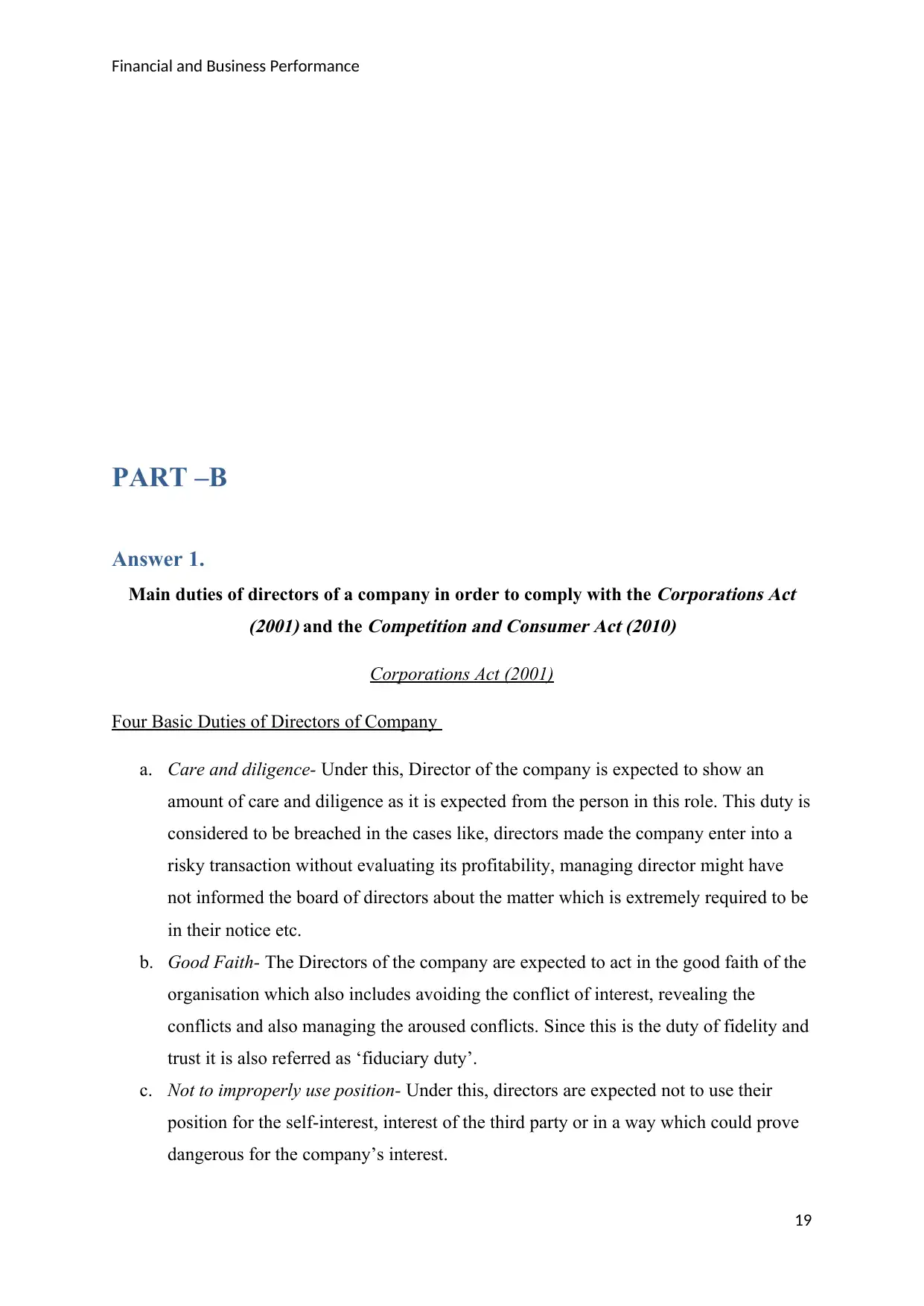
Financial and Business Performance
PART –B
Answer 1.
Main duties of directors of a company in order to comply with the
Corporations Act
(2001) and the
Competition and Consumer Act (2010)
Corporations Act (2001)
Four Basic Duties of Directors of Company
a. Care and diligence- Under this, Director of the company is expected to show an
amount of care and diligence as it is expected from the person in this role. This duty is
considered to be breached in the cases like, directors made the company enter into a
risky transaction without evaluating its profitability, managing director might have
not informed the board of directors about the matter which is extremely required to be
in their notice etc.
b. Good Faith- The Directors of the company are expected to act in the good faith of the
organisation which also includes avoiding the conflict of interest, revealing the
conflicts and also managing the aroused conflicts. Since this is the duty of fidelity and
trust it is also referred as ‘fiduciary duty’.
c. Not to improperly use position- Under this, directors are expected not to use their
position for the self-interest, interest of the third party or in a way which could prove
dangerous for the company’s interest.
19
PART –B
Answer 1.
Main duties of directors of a company in order to comply with the
Corporations Act
(2001) and the
Competition and Consumer Act (2010)
Corporations Act (2001)
Four Basic Duties of Directors of Company
a. Care and diligence- Under this, Director of the company is expected to show an
amount of care and diligence as it is expected from the person in this role. This duty is
considered to be breached in the cases like, directors made the company enter into a
risky transaction without evaluating its profitability, managing director might have
not informed the board of directors about the matter which is extremely required to be
in their notice etc.
b. Good Faith- The Directors of the company are expected to act in the good faith of the
organisation which also includes avoiding the conflict of interest, revealing the
conflicts and also managing the aroused conflicts. Since this is the duty of fidelity and
trust it is also referred as ‘fiduciary duty’.
c. Not to improperly use position- Under this, directors are expected not to use their
position for the self-interest, interest of the third party or in a way which could prove
dangerous for the company’s interest.
19
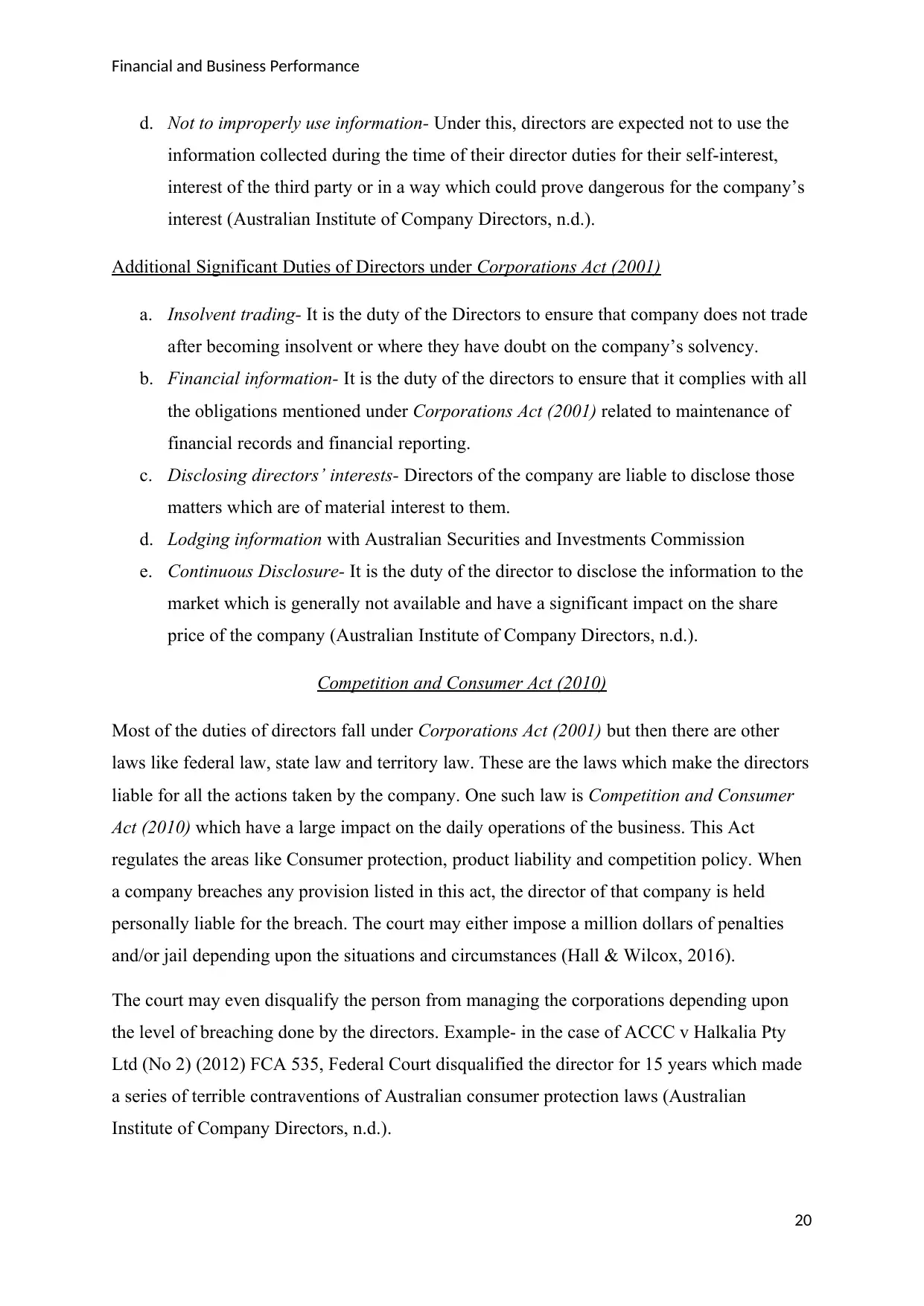
Financial and Business Performance
d. Not to improperly use information- Under this, directors are expected not to use the
information collected during the time of their director duties for their self-interest,
interest of the third party or in a way which could prove dangerous for the company’s
interest (Australian Institute of Company Directors, n.d.).
Additional Significant Duties of Directors under Corporations Act (2001)
a. Insolvent trading- It is the duty of the Directors to ensure that company does not trade
after becoming insolvent or where they have doubt on the company’s solvency.
b. Financial information- It is the duty of the directors to ensure that it complies with all
the obligations mentioned under Corporations Act (2001) related to maintenance of
financial records and financial reporting.
c. Disclosing directors’ interests- Directors of the company are liable to disclose those
matters which are of material interest to them.
d. Lodging information with Australian Securities and Investments Commission
e. Continuous Disclosure- It is the duty of the director to disclose the information to the
market which is generally not available and have a significant impact on the share
price of the company (Australian Institute of Company Directors, n.d.).
Competition and Consumer Act (2010)
Most of the duties of directors fall under Corporations Act (2001) but then there are other
laws like federal law, state law and territory law. These are the laws which make the directors
liable for all the actions taken by the company. One such law is Competition and Consumer
Act (2010) which have a large impact on the daily operations of the business. This Act
regulates the areas like Consumer protection, product liability and competition policy. When
a company breaches any provision listed in this act, the director of that company is held
personally liable for the breach. The court may either impose a million dollars of penalties
and/or jail depending upon the situations and circumstances (Hall & Wilcox, 2016).
The court may even disqualify the person from managing the corporations depending upon
the level of breaching done by the directors. Example- in the case of ACCC v Halkalia Pty
Ltd (No 2) (2012) FCA 535, Federal Court disqualified the director for 15 years which made
a series of terrible contraventions of Australian consumer protection laws (Australian
Institute of Company Directors, n.d.).
20
d. Not to improperly use information- Under this, directors are expected not to use the
information collected during the time of their director duties for their self-interest,
interest of the third party or in a way which could prove dangerous for the company’s
interest (Australian Institute of Company Directors, n.d.).
Additional Significant Duties of Directors under Corporations Act (2001)
a. Insolvent trading- It is the duty of the Directors to ensure that company does not trade
after becoming insolvent or where they have doubt on the company’s solvency.
b. Financial information- It is the duty of the directors to ensure that it complies with all
the obligations mentioned under Corporations Act (2001) related to maintenance of
financial records and financial reporting.
c. Disclosing directors’ interests- Directors of the company are liable to disclose those
matters which are of material interest to them.
d. Lodging information with Australian Securities and Investments Commission
e. Continuous Disclosure- It is the duty of the director to disclose the information to the
market which is generally not available and have a significant impact on the share
price of the company (Australian Institute of Company Directors, n.d.).
Competition and Consumer Act (2010)
Most of the duties of directors fall under Corporations Act (2001) but then there are other
laws like federal law, state law and territory law. These are the laws which make the directors
liable for all the actions taken by the company. One such law is Competition and Consumer
Act (2010) which have a large impact on the daily operations of the business. This Act
regulates the areas like Consumer protection, product liability and competition policy. When
a company breaches any provision listed in this act, the director of that company is held
personally liable for the breach. The court may either impose a million dollars of penalties
and/or jail depending upon the situations and circumstances (Hall & Wilcox, 2016).
The court may even disqualify the person from managing the corporations depending upon
the level of breaching done by the directors. Example- in the case of ACCC v Halkalia Pty
Ltd (No 2) (2012) FCA 535, Federal Court disqualified the director for 15 years which made
a series of terrible contraventions of Australian consumer protection laws (Australian
Institute of Company Directors, n.d.).
20
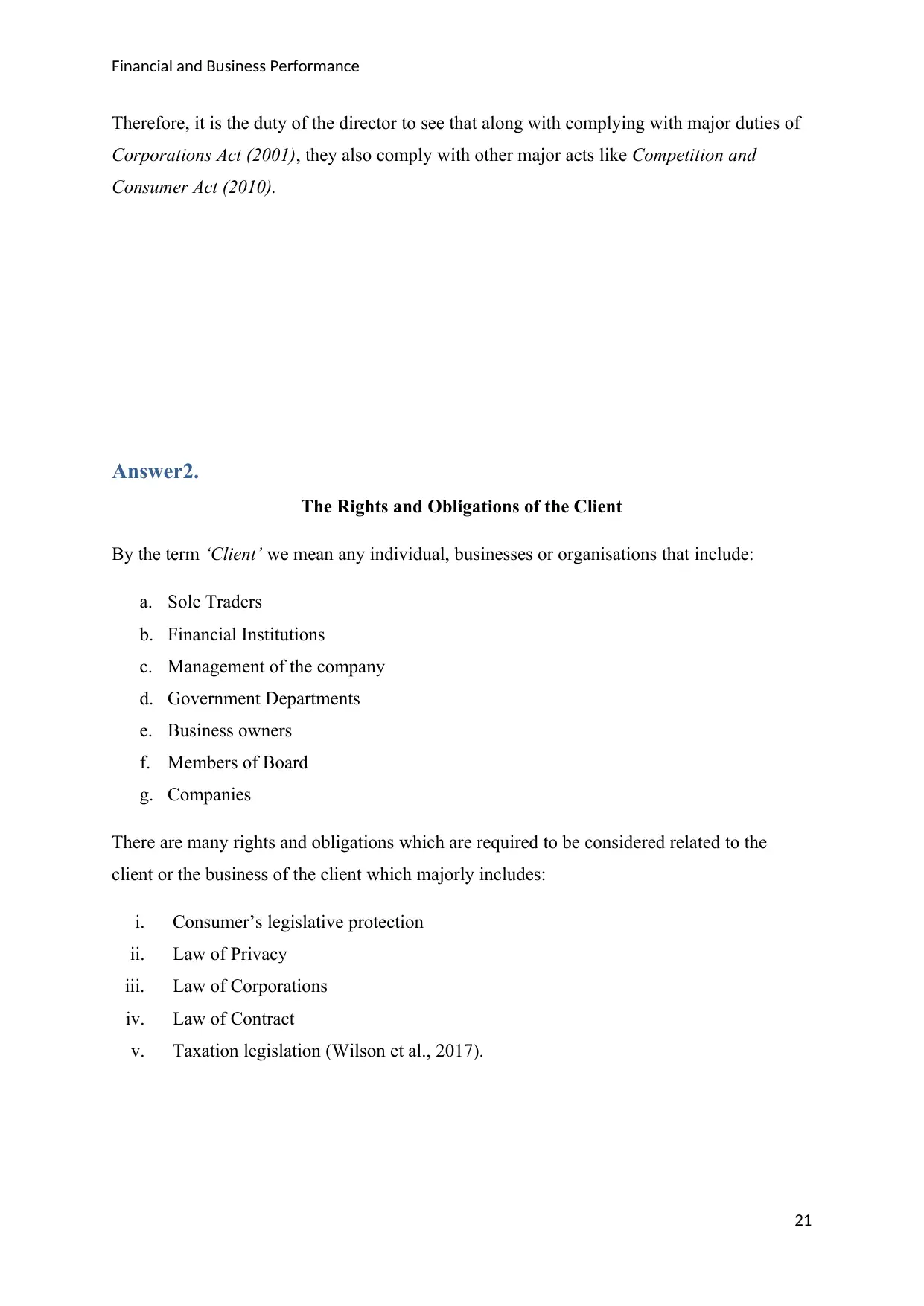
Financial and Business Performance
Therefore, it is the duty of the director to see that along with complying with major duties of
Corporations Act (2001), they also comply with other major acts like Competition and
Consumer Act (2010).
Answer2.
The Rights and Obligations of the Client
By the term ‘Client’ we mean any individual, businesses or organisations that include:
a. Sole Traders
b. Financial Institutions
c. Management of the company
d. Government Departments
e. Business owners
f. Members of Board
g. Companies
There are many rights and obligations which are required to be considered related to the
client or the business of the client which majorly includes:
i. Consumer’s legislative protection
ii. Law of Privacy
iii. Law of Corporations
iv. Law of Contract
v. Taxation legislation (Wilson et al., 2017).
21
Therefore, it is the duty of the director to see that along with complying with major duties of
Corporations Act (2001), they also comply with other major acts like Competition and
Consumer Act (2010).
Answer2.
The Rights and Obligations of the Client
By the term ‘Client’ we mean any individual, businesses or organisations that include:
a. Sole Traders
b. Financial Institutions
c. Management of the company
d. Government Departments
e. Business owners
f. Members of Board
g. Companies
There are many rights and obligations which are required to be considered related to the
client or the business of the client which majorly includes:
i. Consumer’s legislative protection
ii. Law of Privacy
iii. Law of Corporations
iv. Law of Contract
v. Taxation legislation (Wilson et al., 2017).
21
Secure Best Marks with AI Grader
Need help grading? Try our AI Grader for instant feedback on your assignments.
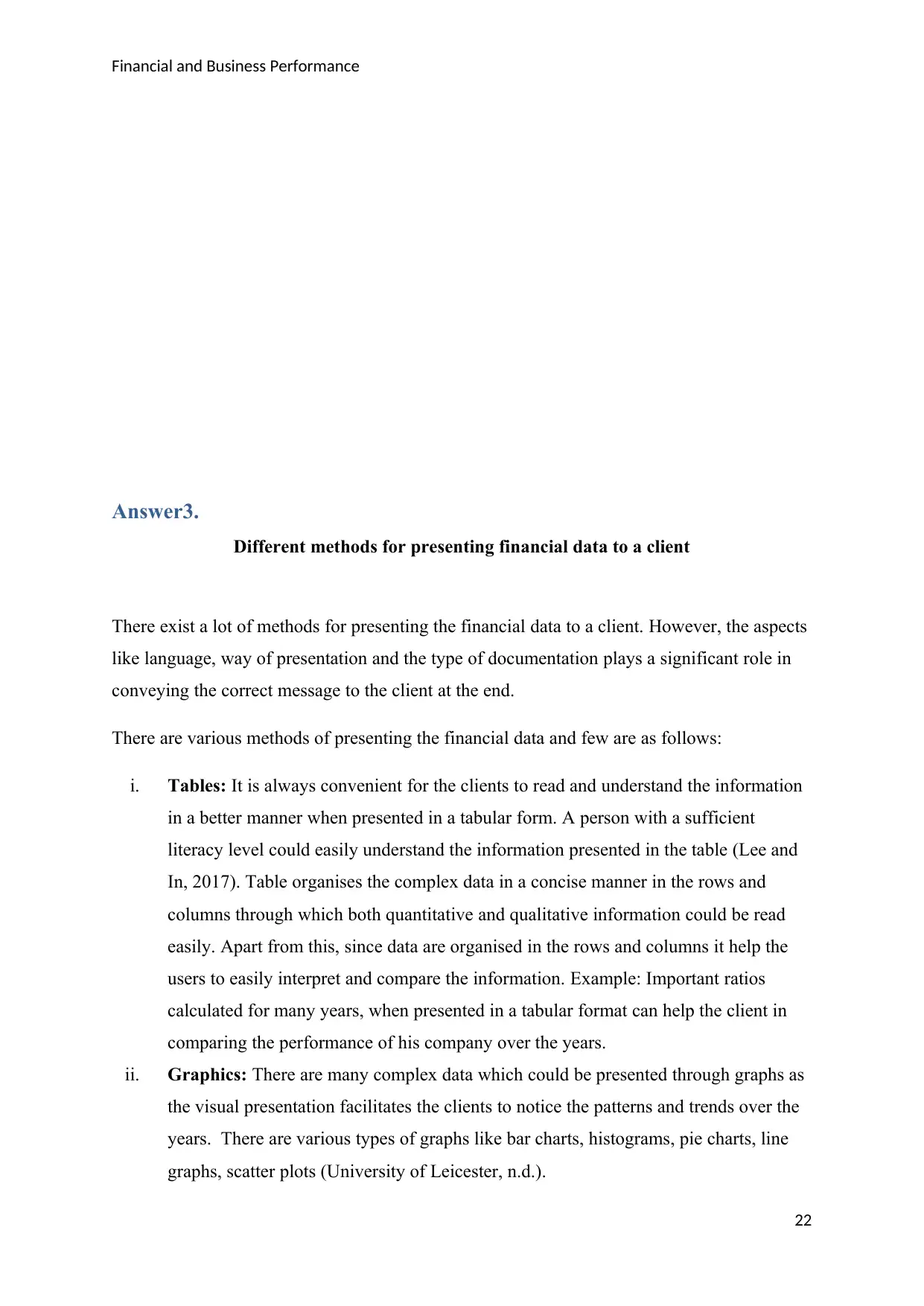
Financial and Business Performance
Answer3.
Different methods for presenting financial data to a client
There exist a lot of methods for presenting the financial data to a client. However, the aspects
like language, way of presentation and the type of documentation plays a significant role in
conveying the correct message to the client at the end.
There are various methods of presenting the financial data and few are as follows:
i. Tables: It is always convenient for the clients to read and understand the information
in a better manner when presented in a tabular form. A person with a sufficient
literacy level could easily understand the information presented in the table (Lee and
In, 2017). Table organises the complex data in a concise manner in the rows and
columns through which both quantitative and qualitative information could be read
easily. Apart from this, since data are organised in the rows and columns it help the
users to easily interpret and compare the information. Example: Important ratios
calculated for many years, when presented in a tabular format can help the client in
comparing the performance of his company over the years.
ii. Graphics: There are many complex data which could be presented through graphs as
the visual presentation facilitates the clients to notice the patterns and trends over the
years. There are various types of graphs like bar charts, histograms, pie charts, line
graphs, scatter plots (University of Leicester, n.d.).
22
Answer3.
Different methods for presenting financial data to a client
There exist a lot of methods for presenting the financial data to a client. However, the aspects
like language, way of presentation and the type of documentation plays a significant role in
conveying the correct message to the client at the end.
There are various methods of presenting the financial data and few are as follows:
i. Tables: It is always convenient for the clients to read and understand the information
in a better manner when presented in a tabular form. A person with a sufficient
literacy level could easily understand the information presented in the table (Lee and
In, 2017). Table organises the complex data in a concise manner in the rows and
columns through which both quantitative and qualitative information could be read
easily. Apart from this, since data are organised in the rows and columns it help the
users to easily interpret and compare the information. Example: Important ratios
calculated for many years, when presented in a tabular format can help the client in
comparing the performance of his company over the years.
ii. Graphics: There are many complex data which could be presented through graphs as
the visual presentation facilitates the clients to notice the patterns and trends over the
years. There are various types of graphs like bar charts, histograms, pie charts, line
graphs, scatter plots (University of Leicester, n.d.).
22
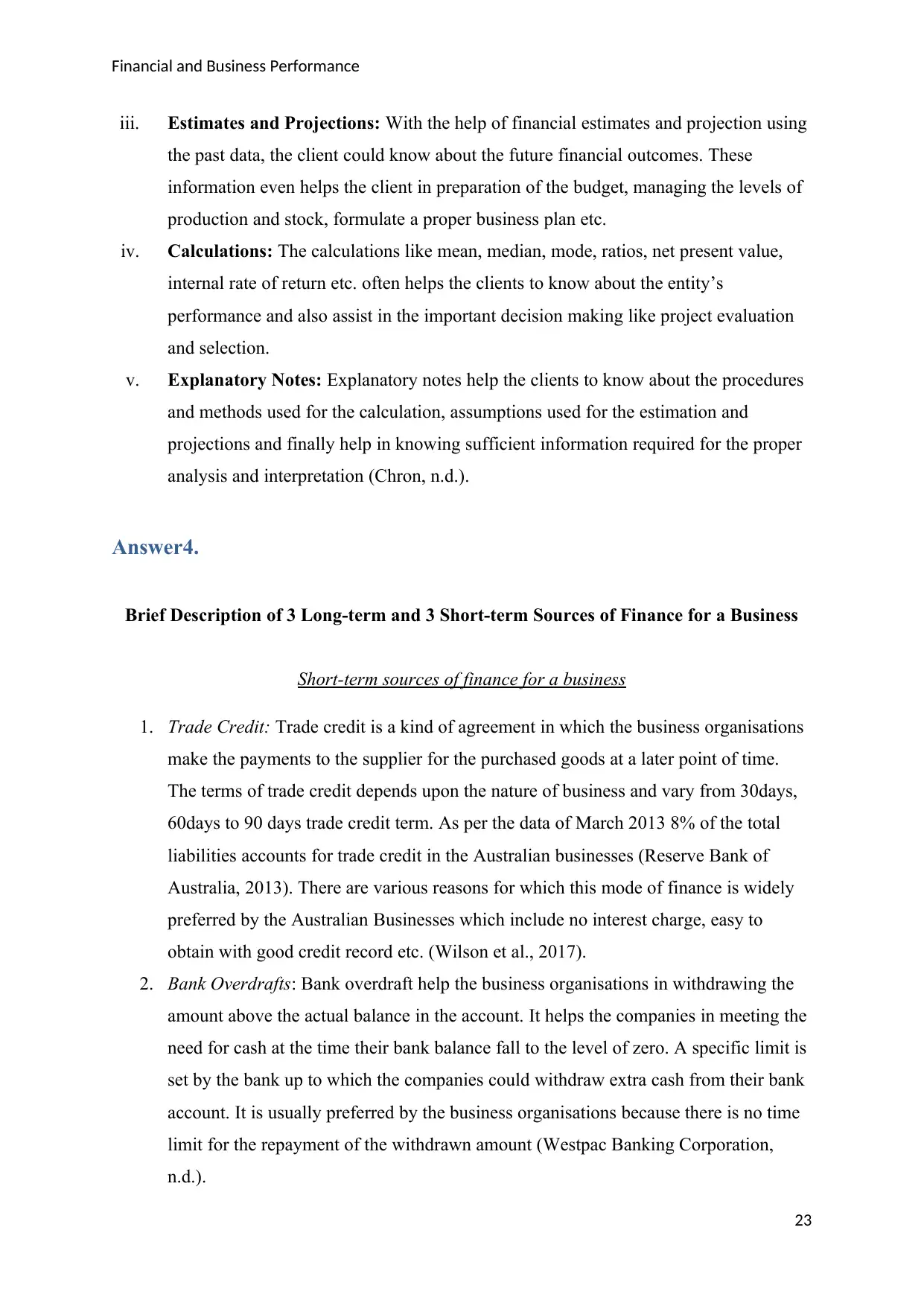
Financial and Business Performance
iii. Estimates and Projections: With the help of financial estimates and projection using
the past data, the client could know about the future financial outcomes. These
information even helps the client in preparation of the budget, managing the levels of
production and stock, formulate a proper business plan etc.
iv. Calculations: The calculations like mean, median, mode, ratios, net present value,
internal rate of return etc. often helps the clients to know about the entity’s
performance and also assist in the important decision making like project evaluation
and selection.
v. Explanatory Notes: Explanatory notes help the clients to know about the procedures
and methods used for the calculation, assumptions used for the estimation and
projections and finally help in knowing sufficient information required for the proper
analysis and interpretation (Chron, n.d.).
Answer4.
Brief Description of 3 Long-term and 3 Short-term Sources of Finance for a Business
Short-term sources of finance for a business
1. Trade Credit: Trade credit is a kind of agreement in which the business organisations
make the payments to the supplier for the purchased goods at a later point of time.
The terms of trade credit depends upon the nature of business and vary from 30days,
60days to 90 days trade credit term. As per the data of March 2013 8% of the total
liabilities accounts for trade credit in the Australian businesses (Reserve Bank of
Australia, 2013). There are various reasons for which this mode of finance is widely
preferred by the Australian Businesses which include no interest charge, easy to
obtain with good credit record etc. (Wilson et al., 2017).
2. Bank Overdrafts: Bank overdraft help the business organisations in withdrawing the
amount above the actual balance in the account. It helps the companies in meeting the
need for cash at the time their bank balance fall to the level of zero. A specific limit is
set by the bank up to which the companies could withdraw extra cash from their bank
account. It is usually preferred by the business organisations because there is no time
limit for the repayment of the withdrawn amount (Westpac Banking Corporation,
n.d.).
23
iii. Estimates and Projections: With the help of financial estimates and projection using
the past data, the client could know about the future financial outcomes. These
information even helps the client in preparation of the budget, managing the levels of
production and stock, formulate a proper business plan etc.
iv. Calculations: The calculations like mean, median, mode, ratios, net present value,
internal rate of return etc. often helps the clients to know about the entity’s
performance and also assist in the important decision making like project evaluation
and selection.
v. Explanatory Notes: Explanatory notes help the clients to know about the procedures
and methods used for the calculation, assumptions used for the estimation and
projections and finally help in knowing sufficient information required for the proper
analysis and interpretation (Chron, n.d.).
Answer4.
Brief Description of 3 Long-term and 3 Short-term Sources of Finance for a Business
Short-term sources of finance for a business
1. Trade Credit: Trade credit is a kind of agreement in which the business organisations
make the payments to the supplier for the purchased goods at a later point of time.
The terms of trade credit depends upon the nature of business and vary from 30days,
60days to 90 days trade credit term. As per the data of March 2013 8% of the total
liabilities accounts for trade credit in the Australian businesses (Reserve Bank of
Australia, 2013). There are various reasons for which this mode of finance is widely
preferred by the Australian Businesses which include no interest charge, easy to
obtain with good credit record etc. (Wilson et al., 2017).
2. Bank Overdrafts: Bank overdraft help the business organisations in withdrawing the
amount above the actual balance in the account. It helps the companies in meeting the
need for cash at the time their bank balance fall to the level of zero. A specific limit is
set by the bank up to which the companies could withdraw extra cash from their bank
account. It is usually preferred by the business organisations because there is no time
limit for the repayment of the withdrawn amount (Westpac Banking Corporation,
n.d.).
23
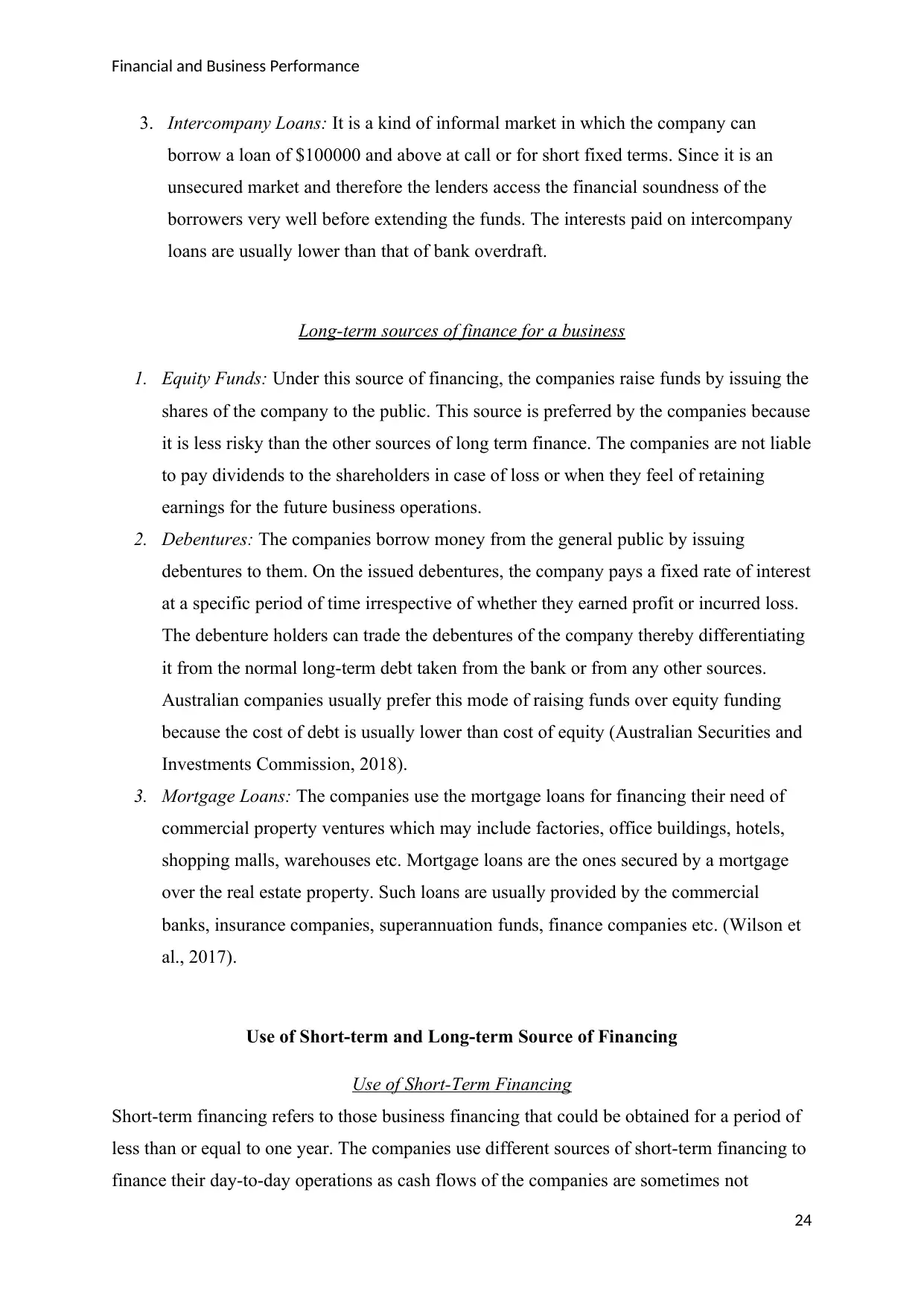
Financial and Business Performance
3. Intercompany Loans: It is a kind of informal market in which the company can
borrow a loan of $100000 and above at call or for short fixed terms. Since it is an
unsecured market and therefore the lenders access the financial soundness of the
borrowers very well before extending the funds. The interests paid on intercompany
loans are usually lower than that of bank overdraft.
Long-term sources of finance for a business
1. Equity Funds: Under this source of financing, the companies raise funds by issuing the
shares of the company to the public. This source is preferred by the companies because
it is less risky than the other sources of long term finance. The companies are not liable
to pay dividends to the shareholders in case of loss or when they feel of retaining
earnings for the future business operations.
2. Debentures: The companies borrow money from the general public by issuing
debentures to them. On the issued debentures, the company pays a fixed rate of interest
at a specific period of time irrespective of whether they earned profit or incurred loss.
The debenture holders can trade the debentures of the company thereby differentiating
it from the normal long-term debt taken from the bank or from any other sources.
Australian companies usually prefer this mode of raising funds over equity funding
because the cost of debt is usually lower than cost of equity (Australian Securities and
Investments Commission, 2018).
3. Mortgage Loans: The companies use the mortgage loans for financing their need of
commercial property ventures which may include factories, office buildings, hotels,
shopping malls, warehouses etc. Mortgage loans are the ones secured by a mortgage
over the real estate property. Such loans are usually provided by the commercial
banks, insurance companies, superannuation funds, finance companies etc. (Wilson et
al., 2017).
Use of Short-term and Long-term Source of Financing
Use of Short-Term Financing
Short-term financing refers to those business financing that could be obtained for a period of
less than or equal to one year. The companies use different sources of short-term financing to
finance their day-to-day operations as cash flows of the companies are sometimes not
24
3. Intercompany Loans: It is a kind of informal market in which the company can
borrow a loan of $100000 and above at call or for short fixed terms. Since it is an
unsecured market and therefore the lenders access the financial soundness of the
borrowers very well before extending the funds. The interests paid on intercompany
loans are usually lower than that of bank overdraft.
Long-term sources of finance for a business
1. Equity Funds: Under this source of financing, the companies raise funds by issuing the
shares of the company to the public. This source is preferred by the companies because
it is less risky than the other sources of long term finance. The companies are not liable
to pay dividends to the shareholders in case of loss or when they feel of retaining
earnings for the future business operations.
2. Debentures: The companies borrow money from the general public by issuing
debentures to them. On the issued debentures, the company pays a fixed rate of interest
at a specific period of time irrespective of whether they earned profit or incurred loss.
The debenture holders can trade the debentures of the company thereby differentiating
it from the normal long-term debt taken from the bank or from any other sources.
Australian companies usually prefer this mode of raising funds over equity funding
because the cost of debt is usually lower than cost of equity (Australian Securities and
Investments Commission, 2018).
3. Mortgage Loans: The companies use the mortgage loans for financing their need of
commercial property ventures which may include factories, office buildings, hotels,
shopping malls, warehouses etc. Mortgage loans are the ones secured by a mortgage
over the real estate property. Such loans are usually provided by the commercial
banks, insurance companies, superannuation funds, finance companies etc. (Wilson et
al., 2017).
Use of Short-term and Long-term Source of Financing
Use of Short-Term Financing
Short-term financing refers to those business financing that could be obtained for a period of
less than or equal to one year. The companies use different sources of short-term financing to
finance their day-to-day operations as cash flows of the companies are sometimes not
24
Paraphrase This Document
Need a fresh take? Get an instant paraphrase of this document with our AI Paraphraser
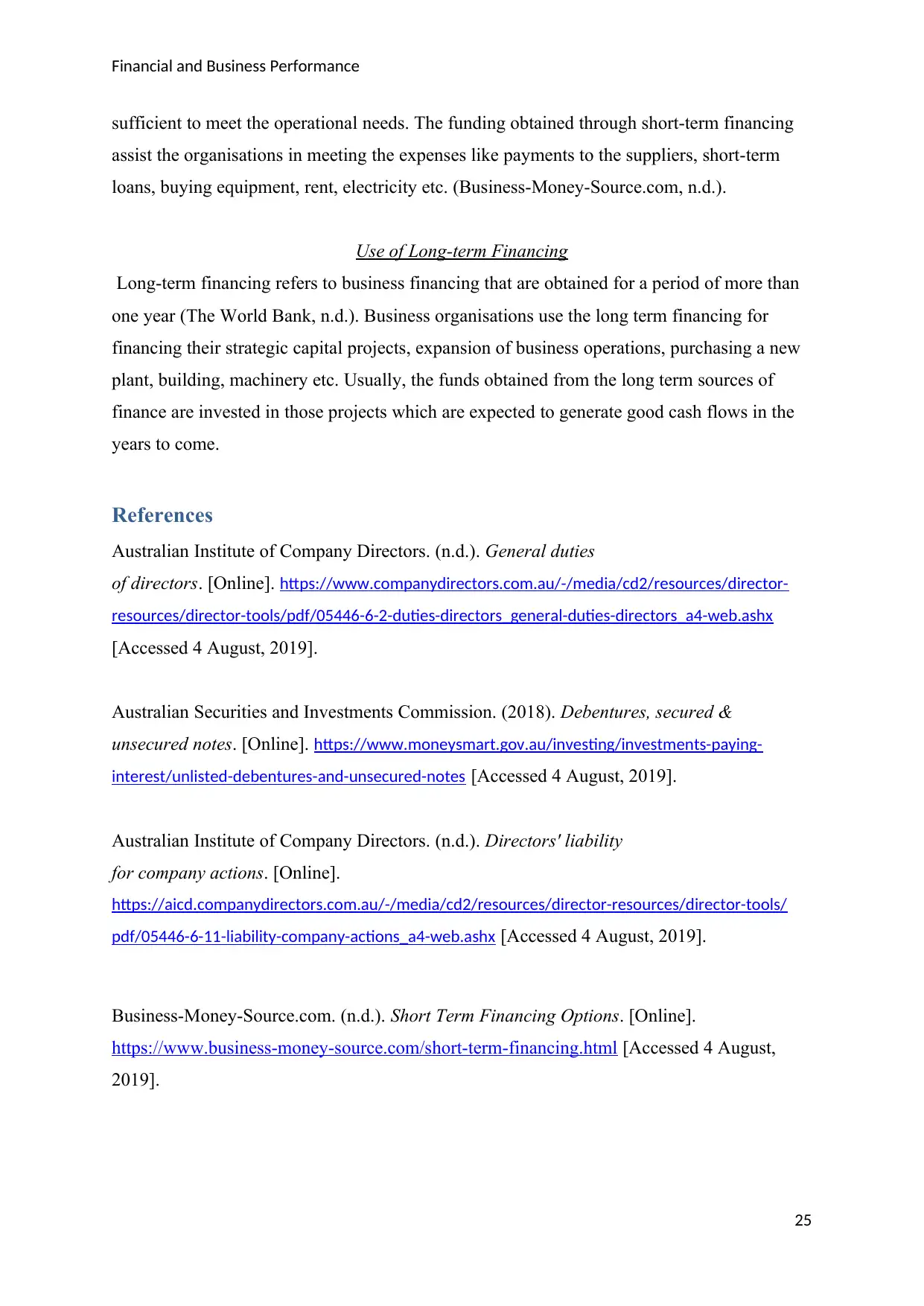
Financial and Business Performance
sufficient to meet the operational needs. The funding obtained through short-term financing
assist the organisations in meeting the expenses like payments to the suppliers, short-term
loans, buying equipment, rent, electricity etc. (Business-Money-Source.com, n.d.).
Use of Long-term Financing
Long-term financing refers to business financing that are obtained for a period of more than
one year (The World Bank, n.d.). Business organisations use the long term financing for
financing their strategic capital projects, expansion of business operations, purchasing a new
plant, building, machinery etc. Usually, the funds obtained from the long term sources of
finance are invested in those projects which are expected to generate good cash flows in the
years to come.
References
Australian Institute of Company Directors. (n.d.). General duties
of directors. [Online]. https://www.companydirectors.com.au/-/media/cd2/resources/director-
resources/director-tools/pdf/05446-6-2-duties-directors_general-duties-directors_a4-web.ashx
[Accessed 4 August, 2019].
Australian Securities and Investments Commission. (2018). Debentures, secured &
unsecured notes. [Online]. https://www.moneysmart.gov.au/investing/investments-paying-
interest/unlisted-debentures-and-unsecured-notes [Accessed 4 August, 2019].
Australian Institute of Company Directors. (n.d.). Directors' liability
for company actions. [Online].
https://aicd.companydirectors.com.au/-/media/cd2/resources/director-resources/director-tools/
pdf/05446-6-11-liability-company-actions_a4-web.ashx [Accessed 4 August, 2019].
Business-Money-Source.com. (n.d.). Short Term Financing Options. [Online].
https://www.business-money-source.com/short-term-financing.html [Accessed 4 August,
2019].
25
sufficient to meet the operational needs. The funding obtained through short-term financing
assist the organisations in meeting the expenses like payments to the suppliers, short-term
loans, buying equipment, rent, electricity etc. (Business-Money-Source.com, n.d.).
Use of Long-term Financing
Long-term financing refers to business financing that are obtained for a period of more than
one year (The World Bank, n.d.). Business organisations use the long term financing for
financing their strategic capital projects, expansion of business operations, purchasing a new
plant, building, machinery etc. Usually, the funds obtained from the long term sources of
finance are invested in those projects which are expected to generate good cash flows in the
years to come.
References
Australian Institute of Company Directors. (n.d.). General duties
of directors. [Online]. https://www.companydirectors.com.au/-/media/cd2/resources/director-
resources/director-tools/pdf/05446-6-2-duties-directors_general-duties-directors_a4-web.ashx
[Accessed 4 August, 2019].
Australian Securities and Investments Commission. (2018). Debentures, secured &
unsecured notes. [Online]. https://www.moneysmart.gov.au/investing/investments-paying-
interest/unlisted-debentures-and-unsecured-notes [Accessed 4 August, 2019].
Australian Institute of Company Directors. (n.d.). Directors' liability
for company actions. [Online].
https://aicd.companydirectors.com.au/-/media/cd2/resources/director-resources/director-tools/
pdf/05446-6-11-liability-company-actions_a4-web.ashx [Accessed 4 August, 2019].
Business-Money-Source.com. (n.d.). Short Term Financing Options. [Online].
https://www.business-money-source.com/short-term-financing.html [Accessed 4 August,
2019].
25
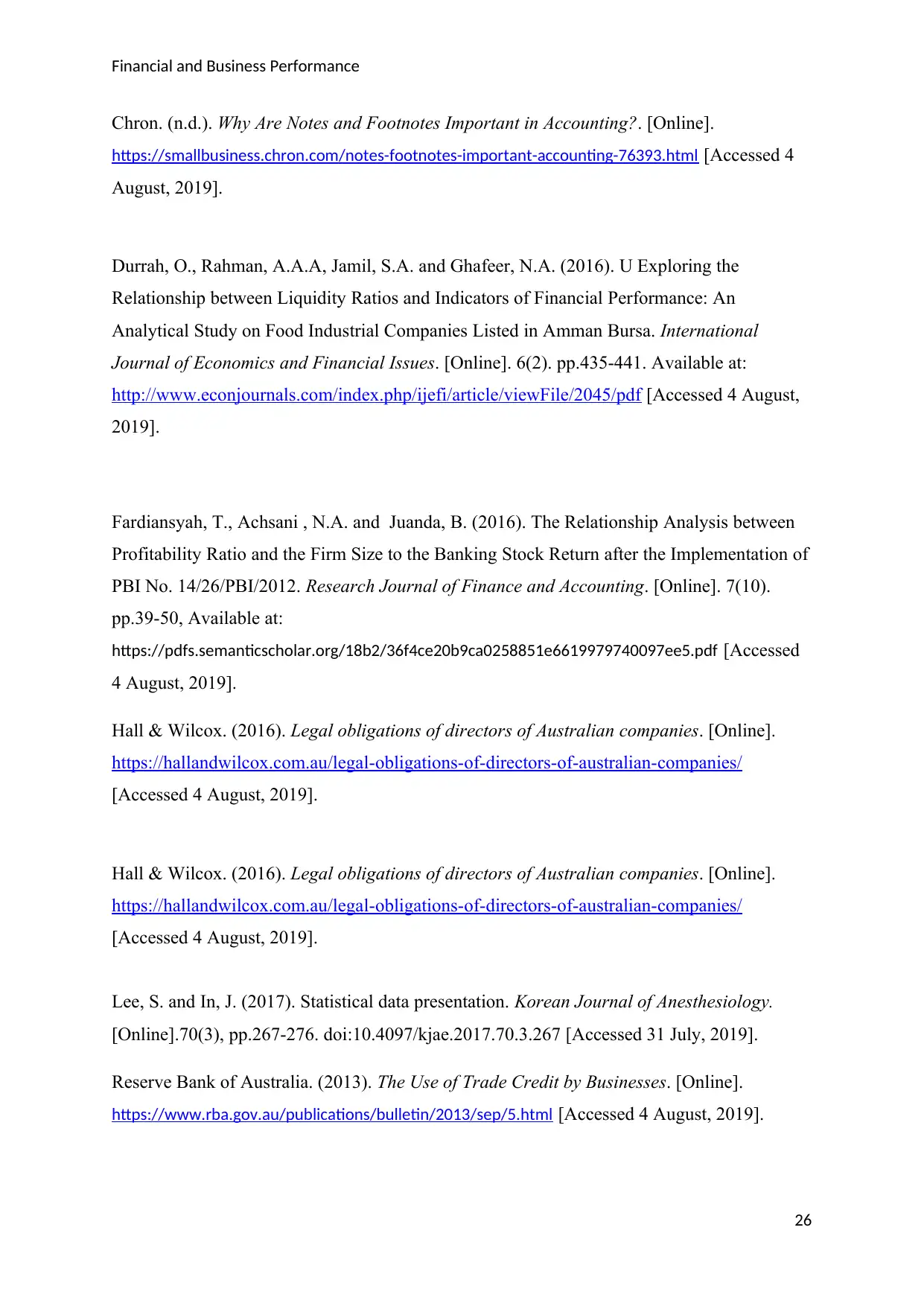
Financial and Business Performance
Chron. (n.d.). Why Are Notes and Footnotes Important in Accounting?. [Online].
https://smallbusiness.chron.com/notes-footnotes-important-accounting-76393.html [Accessed 4
August, 2019].
Durrah, O., Rahman, A.A.A, Jamil, S.A. and Ghafeer, N.A. (2016). U Exploring the
Relationship between Liquidity Ratios and Indicators of Financial Performance: An
Analytical Study on Food Industrial Companies Listed in Amman Bursa. International
Journal of Economics and Financial Issues. [Online]. 6(2). pp.435-441. Available at:
http://www.econjournals.com/index.php/ijefi/article/viewFile/2045/pdf [Accessed 4 August,
2019].
Fardiansyah, T., Achsani , N.A. and Juanda, B. (2016). The Relationship Analysis between
Profitability Ratio and the Firm Size to the Banking Stock Return after the Implementation of
PBI No. 14/26/PBI/2012. Research Journal of Finance and Accounting. [Online]. 7(10).
pp.39-50, Available at:
https://pdfs.semanticscholar.org/18b2/36f4ce20b9ca0258851e6619979740097ee5.pdf [Accessed
4 August, 2019].
Hall & Wilcox. (2016). Legal obligations of directors of Australian companies. [Online].
https://hallandwilcox.com.au/legal-obligations-of-directors-of-australian-companies/
[Accessed 4 August, 2019].
Hall & Wilcox. (2016). Legal obligations of directors of Australian companies. [Online].
https://hallandwilcox.com.au/legal-obligations-of-directors-of-australian-companies/
[Accessed 4 August, 2019].
Lee, S. and In, J. (2017). Statistical data presentation. Korean Journal of Anesthesiology.
[Online].70(3), pp.267-276. doi:10.4097/kjae.2017.70.3.267 [Accessed 31 July, 2019].
Reserve Bank of Australia. (2013). The Use of Trade Credit by Businesses. [Online].
https://www.rba.gov.au/publications/bulletin/2013/sep/5.html [Accessed 4 August, 2019].
26
Chron. (n.d.). Why Are Notes and Footnotes Important in Accounting?. [Online].
https://smallbusiness.chron.com/notes-footnotes-important-accounting-76393.html [Accessed 4
August, 2019].
Durrah, O., Rahman, A.A.A, Jamil, S.A. and Ghafeer, N.A. (2016). U Exploring the
Relationship between Liquidity Ratios and Indicators of Financial Performance: An
Analytical Study on Food Industrial Companies Listed in Amman Bursa. International
Journal of Economics and Financial Issues. [Online]. 6(2). pp.435-441. Available at:
http://www.econjournals.com/index.php/ijefi/article/viewFile/2045/pdf [Accessed 4 August,
2019].
Fardiansyah, T., Achsani , N.A. and Juanda, B. (2016). The Relationship Analysis between
Profitability Ratio and the Firm Size to the Banking Stock Return after the Implementation of
PBI No. 14/26/PBI/2012. Research Journal of Finance and Accounting. [Online]. 7(10).
pp.39-50, Available at:
https://pdfs.semanticscholar.org/18b2/36f4ce20b9ca0258851e6619979740097ee5.pdf [Accessed
4 August, 2019].
Hall & Wilcox. (2016). Legal obligations of directors of Australian companies. [Online].
https://hallandwilcox.com.au/legal-obligations-of-directors-of-australian-companies/
[Accessed 4 August, 2019].
Hall & Wilcox. (2016). Legal obligations of directors of Australian companies. [Online].
https://hallandwilcox.com.au/legal-obligations-of-directors-of-australian-companies/
[Accessed 4 August, 2019].
Lee, S. and In, J. (2017). Statistical data presentation. Korean Journal of Anesthesiology.
[Online].70(3), pp.267-276. doi:10.4097/kjae.2017.70.3.267 [Accessed 31 July, 2019].
Reserve Bank of Australia. (2013). The Use of Trade Credit by Businesses. [Online].
https://www.rba.gov.au/publications/bulletin/2013/sep/5.html [Accessed 4 August, 2019].
26
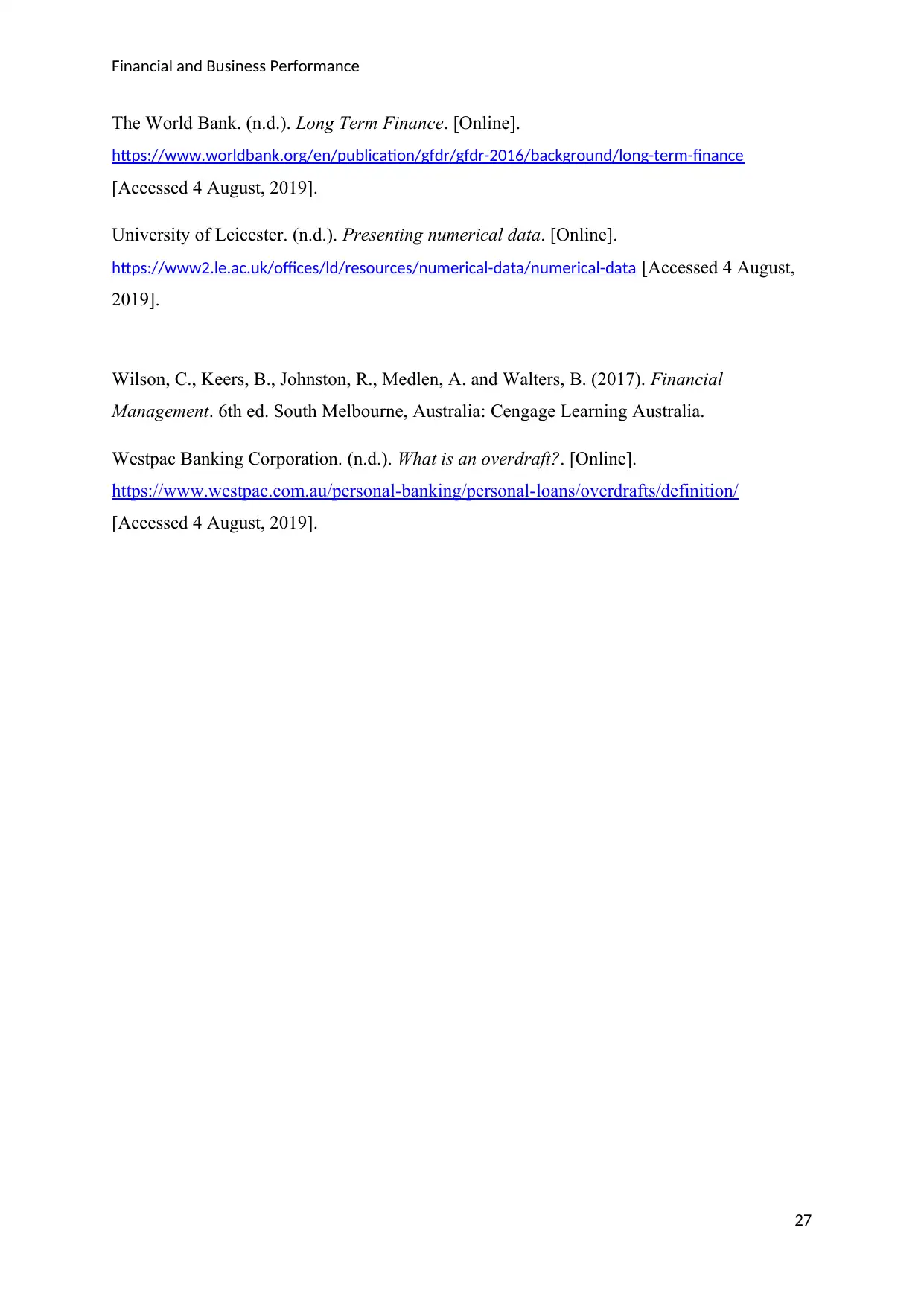
Financial and Business Performance
The World Bank. (n.d.). Long Term Finance. [Online].
https://www.worldbank.org/en/publication/gfdr/gfdr-2016/background/long-term-finance
[Accessed 4 August, 2019].
University of Leicester. (n.d.). Presenting numerical data. [Online].
https://www2.le.ac.uk/offices/ld/resources/numerical-data/numerical-data [Accessed 4 August,
2019].
Wilson, C., Keers, B., Johnston, R., Medlen, A. and Walters, B. (2017). Financial
Management. 6th ed. South Melbourne, Australia: Cengage Learning Australia.
Westpac Banking Corporation. (n.d.). What is an overdraft?. [Online].
https://www.westpac.com.au/personal-banking/personal-loans/overdrafts/definition/
[Accessed 4 August, 2019].
27
The World Bank. (n.d.). Long Term Finance. [Online].
https://www.worldbank.org/en/publication/gfdr/gfdr-2016/background/long-term-finance
[Accessed 4 August, 2019].
University of Leicester. (n.d.). Presenting numerical data. [Online].
https://www2.le.ac.uk/offices/ld/resources/numerical-data/numerical-data [Accessed 4 August,
2019].
Wilson, C., Keers, B., Johnston, R., Medlen, A. and Walters, B. (2017). Financial
Management. 6th ed. South Melbourne, Australia: Cengage Learning Australia.
Westpac Banking Corporation. (n.d.). What is an overdraft?. [Online].
https://www.westpac.com.au/personal-banking/personal-loans/overdrafts/definition/
[Accessed 4 August, 2019].
27
1 out of 28
Related Documents
Your All-in-One AI-Powered Toolkit for Academic Success.
+13062052269
info@desklib.com
Available 24*7 on WhatsApp / Email
![[object Object]](/_next/static/media/star-bottom.7253800d.svg)
Unlock your academic potential
© 2024 | Zucol Services PVT LTD | All rights reserved.





